3 Days in Lisbon: A Perfect Itinerary for First Timers
We love Lisbon. It’s the largest city in Portugal – also the capital – with a rich history that features a diverse cast of characters, from the Romans and Visigoths in medieval times, to the Islamic Caliphates hailing from North Africa, to the Christian Crusaders, and many more.
They were also the first people to go around the Cape of Good Hope, the southern tip of Africa to India (you can see Vasco da Gama’s tomb at the Jerónimos Monastery in Belém), and the fact that Portugal played such a big role in early exploration at sea is something I always forget.
Over the course of your time in Lisbon, you’ll learn all about the rich history – some good, some not so good – that was made in Lisbon, one of the most storied cities in all of Europe.
As we were on a walking tour with Isabel, a local who now lives in a suburb of Lisbon, she was telling us about the earthquake in 1755 (and the fires and tsunami that soon followed) that leveled large swaths of Lisbon.
Huge swaths of the city had to be rebuilt from the ground up, which immediately reminded me of the forest fires in the western United States that have grown more and more intense with each passing year.
In their wake, they leave destruction and suffering. But then a beautiful thing happens.
From the ashes, something new emerges. In the case of our forests at home, it’s a new set of flora and fauna.
In Lisbon’s case, a modern city emerged, more resilient and equipped to deal with future disasters thanks, in part, to the urban planning of Baixa, which was envisioned and brought to life by the Prime Minister after the earthquake, Marquês de Pombal.
The Portuguese capital is a real treat, full of incredible views from miradouros that look out over the colorful buildings adorning the city’s many hills, great food and drinks including fresh seafood that is among the best in the world, and some amazing historical sights and stories.
In this guide to planning your trip to Lisbon, you’ll find a detailed 3 day Lisbon itinerary, complete with things to do, see, eat, and drink, along with the important details you need to know to have a memorable trip.
You’ll also find logistics – like how to get around and some useful tips and tricks for visiting Lisbon – that are important for planning your trip.
We hope you enjoy this guide, that you find it helpful for planning your trip, and we help you discover something new and exciting, whether it’s your first time, or tenth.
Sound good to you? Let’s get into it.
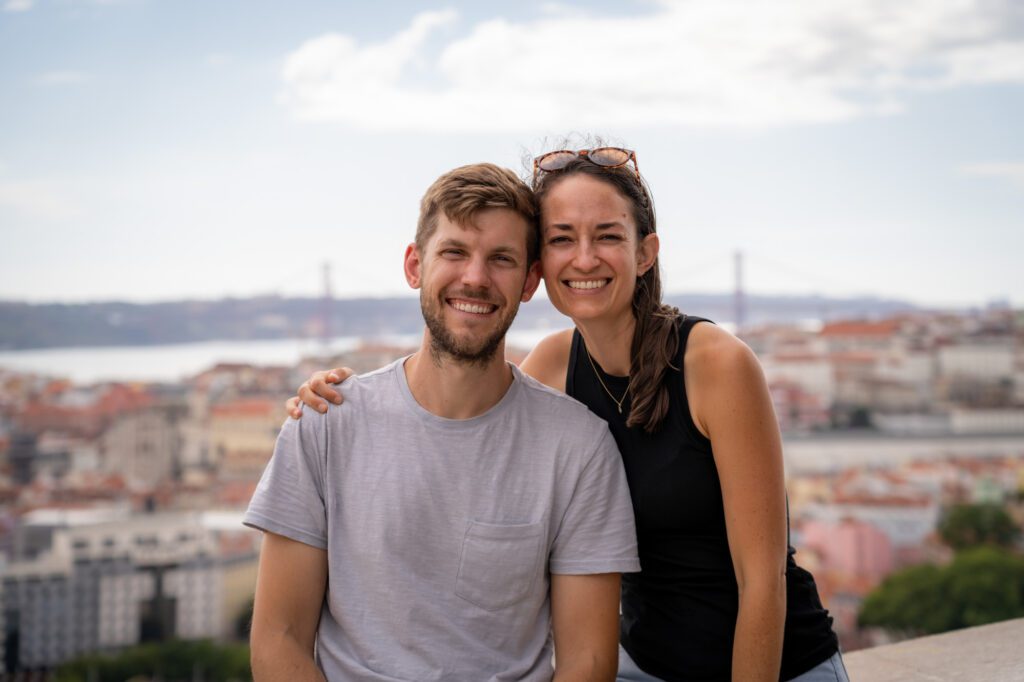
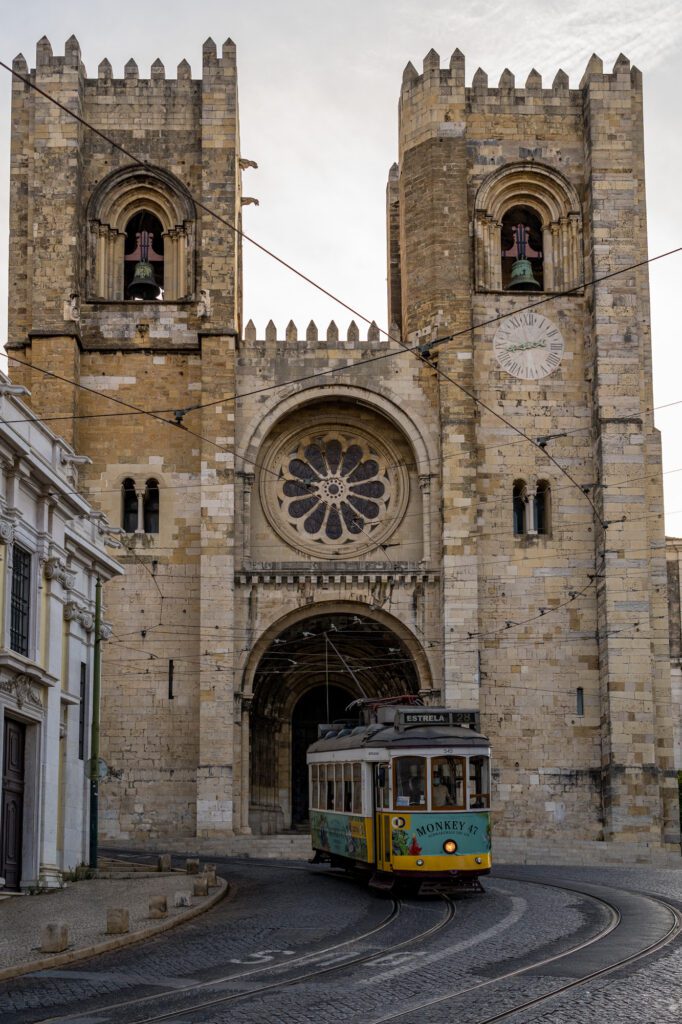

Disclaimer: Some of the links in this post, like hotel links, are affiliate links, meaning at no additional cost to you, we make a little bit of money if you click through and book. That being said, we would never recommend something to you that we don’t stand behind 100%.
How Many Days Do You Need in Lisbon?
For bigger European capitals (think Paris, Rome, London, etc), this section usually says something like “no, X days is not really enough time, but that’s okay and we’re here to help.”
For Lisbon, we’d actually argue that three days is a solid amount of time.
It gives you two days to dedicate to the city itself – and we’d argue that you should definitely give yourself a full two days for Lisbon – and a day to visit Sintra, which is a short journey outside of Lisbon.
One thing to know about Lisbon is that it’s much more of a city that is just a nice place to wander, eat and drink, and generally just exist, rather than having a big long list of attractions you want to check out.
There are a couple of considerations that we’re trying to balance when we choose how many days to recommend in a city.
On one hand, we want to make sure that you have enough time to get a feeling for what makes the place special, which almost always means AT LEAST two days in any city.
On the other hand, we also want to be cognizant of limited vacation time, so while we absolutely would love to recommend you spend a week exploring a city, it’s not particularly practical for most visitors.
We think that Lisbon is worthy of at least two days, but it’s a city where there aren’t really that many “major” attractions (like museums), and it’s much more about exploring neighborhoods and eating some good food.
All that is to say that we think three days is a good balance that gives you enough time to see the city’s highlights and start to gain an understanding of what makes Lisbon special.
Could you spend more time in Lisbon? Absolutely, and we have some ideas below the main itinerary on what to do with that extra time.
Where to Stay in Lisbon
When you’re thinking about central Lisbon – the part of the city that you’ll likely want to stay in (especially if it’s your first time) – you can basically think about it as two hills and the valley between them, with the river (the Tagus) acting as a natural border for the city center.
The valley is called “Baixa” and is the most modern part of the city because it’s the place most affected by the fire that decimated Lisbon in the 18th Century (and stalled Portugal’s development).
Similar to other big European capitals (London is a great example), that fire allowed for more modern urban planning, and Baixa is the most gridded section of Lisbon for that reason.
It’s also the most well-connected with buses, trams, and an underground metro running through it.
It’s probably the best place to stay if you have mobility restrictions since it’s flat, but you’ll still have to climb a hill to go basically anywhere in Lisbon.
The hill on the north side of Baixa is where you’ll find Alfama, the most charming part of the city. It’s also the least accessible in terms of public transportation (except for the popular tram 28).
Though it’s tempting to use Alfama as your home base, we’d strongly recommend that you plan on visiting but stay elsewhere.
There are two areas that we think are a cut above the rest – Baixa, the aforementioned modern and utilitarian part of the city (with great transit connections) and Chiado, the more charming part of the city up on the hill.
Chiado: Our #1 Recommendation in Lisbon
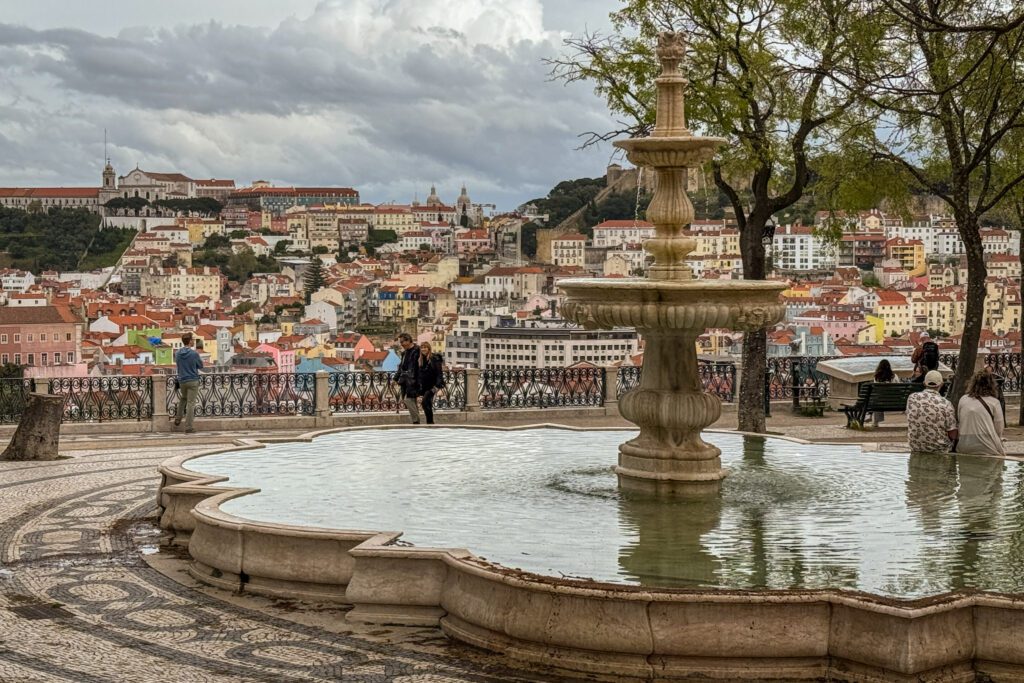
Our top recommendation is up the hill in a very central location, Chiado, and it’s the best location in Lisbon (we think) because it’s a 15 minute walk to basically everything, and the trams run right through the center of the neighborhood.
Casa do Barao is our number one recommendation here, and we have it saved for our next trip to Lisbon.
It’s a little bit of a splurge for sure, but the property is gorgeous and the spacious rooms with terraces overlooking the pool are what dreams are made of.
A few years ago, my mom went to Portugal (including Lisbon) and, unsurprisingly, used a lot of our guides to plan her trip.
I ended up helping her pick a place to stay – an aparthotel called 54 São Paulo – which she absolutely loved.
Baixa: A More Utilitarian Option
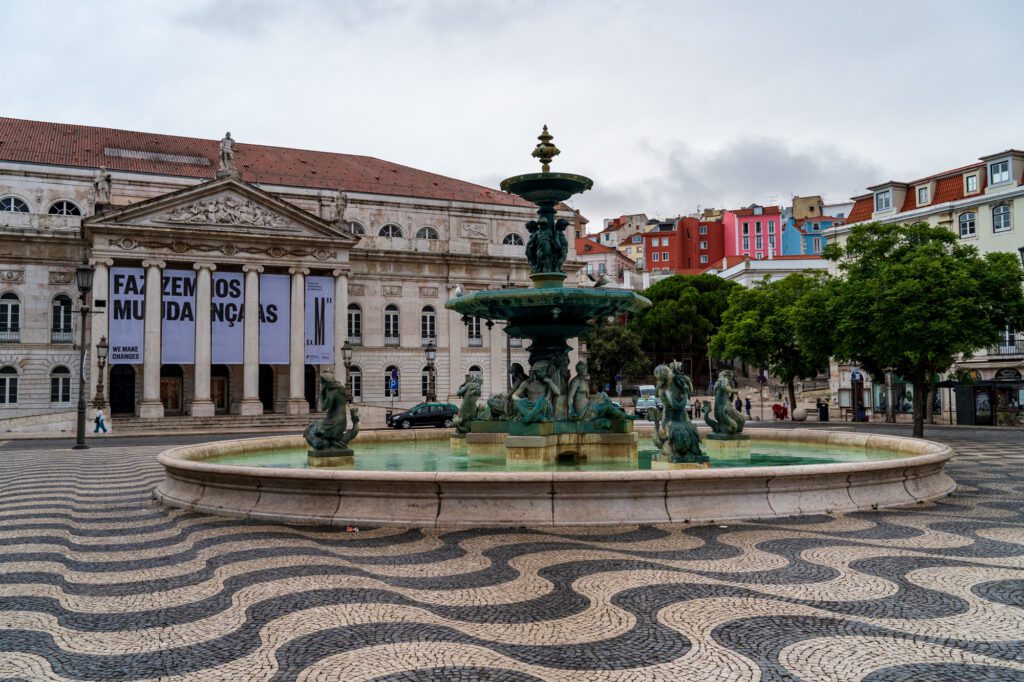
You know, as I’m sitting here writing this, I have just finished the Chiado section above that says “our number one recommendation is Chiado” and, despite that recommendation – which I stand by – I realized that we almost always stay in Baixa when we’re in Lisbon because it is just SO convenient.
Baixa is the gridded “downtown” neighborhood that sits in the valley between Lisbon’s two big hills, and it’s the part of the city that was essentially completely destroyed during the 1755 earthquake and subsequent tsunami.
Because it was re-planned in the 18th Century, you tend to see more modern urban planning in this part of the city, with a grid system and some pedestrianized streets, which makes it a little easier to get around and navigate.
It’s also well connected via the trams, buses, and metro system to basically anywhere else you want to go in Lisbon (or Portugal more broadly thanks to the proximity to Rossio Station).
We’d highly recommend staying around Praça Dom Pedro IV (which is the one outside of Rossio Station) or on the adjacent Praça da Figueira, which is about as convenient a location as you can possibly get at the base of both hills.
There are two great midrange hotels here – My Story Hotel Figueira and My Story Hotel Rossio – which would be a solid option.
I (Matt) stayed at the Visionaire Apartments on Praça da Figueira (which is right next to Rossio Square) and loved it.
It’s super convenient for going just about anywhere in Lisbon, and the apartments themselves were in great shape with nice views out over the square below (though it was significantly less loud than I expected).
3 Days in Lisbon: A Perfect Itinerary for First Timers
And now, into the itinerary we go.
We have a secret for you. And it’s a lesson that it took us years of traveling to finally learn on our three month European extravaganza a few years ago (if you don’t know our story, you can read it here).
Travel is better – and by better, we mean more rewarding, interesting, and fun – when you try your best to connect with locals to see the place through their eyes.
I (Matt here!) took that to heart on my last visit to Lisbon in an effort to better understand what makes the city special, and came away with a much richer understanding of Lisbon’s unique culture and point of view on life.
Particularly on that latest trip, I did a bunch of different tours and experiences (I’ve included the ones that I thought were particularly special in the guide below) that opened my eyes to a new side of the city, culture, and people.
Our biggest tip for Lisbon (or any city, really) is to prioritize tours that connect you with locals and allow you to get a unique perspective on the city (which is what you’re going to see in this itinerary).
Here is what the itinerary we’ll detail below looks like written out:
- Day 1: Getting Oriented (Baixa, Chiado, and Alfama)
- Day 2: Dive into Lisbon’s Food Culture + Belém
- Day 3: A Day Trip to Sintra
Keep in mind that we are assuming you have three full days. You’ll have to massage and change things to fit your specific arrival and departure times.
Last, but certainly not least, we’re not going to give specific recommendations on places to eat for two reasons.
One, Matt has Celiac Disease and the gluten free food in Lisbon is fine, but nothing particularly special. So we’re not really the right people to give that advice (except for the best gluten free restaurants in Lisbon, which we have plenty of opinions about).
Two, it depends so much on your tastes and budget. So we’ll let you figure that out on your own, for the most part.
Day 1: Getting Oriented (Baixa, Chiado, and Alfama)
On your first day in Lisbon, we’d spend the entire day exploring the central part of Lisbon, which includes the two hills (Chiado/Bairro Alto and Alfama) and the valley between them.
Understanding the relationship between them and the history here will set a great foundation for the rest of your trip.
Get Oriented with a Walking Tour
Walking tours are our favorite way to get oriented in a new city for a few reasons.
First, you get a crash course in history and culture, which is a valuable baseline that will make the rest of your trip more enjoyable.
Second, you get to spend a few hours with a local who will give you all sorts of tips about what to eat, drink (and see), and specifically where to find the best version of said things.
Last but not least, you’ll discover places that you definitely would never have found on your own.
We always do a walking tour on our first day in a city, and Lisbon was no different.
We’ve actually done several walking tours in Lisbon at this point (walking tours are Matt’s favorite way to learn about a city), and have three recommendations based on what you’re looking for.
On our first day in Lisbon a few years ago, we had a group of four (us and Matt’s two brothers) and we scheduled a walking tour with Withlocals for our first afternoon so that we had something to do (other than fall asleep due to jet lag).
The tour we did is the “Lisbon Highlights and Hidden Gems” tour, which is a great introduction to the city.
Withlocals is a tour company that we’ve fallen in love with in Europe, and have basically used in every city we’ve visited over the last few years where tours are available.
They’re perfect because they’re private tours (at regular tour prices, I might add, especially if you have more than two people), and thus they’re customizable to your particular needs and interests.
We did a tour with Isabel in Lisbon, and highly highly recommend her as a guide.
If you’re not a group of 3+, the private tours might not work out as well from a money standpoint, and we have a couple of group tour recommendations too.
On my latest trip to Lisbon, I was in search of a walking tour to do on my first day to get reacquainted with the city and ended up as the only participant on Humberto’s LisboaLove walk.
It’s a small group tour that focuses on the history of Lisbon and makes its way through Bairro Alto up on the hill, which is where Humberto grew up (it also means that you’re spending most of your time in a neighborhood that only a fraction of tourists ever make it to).
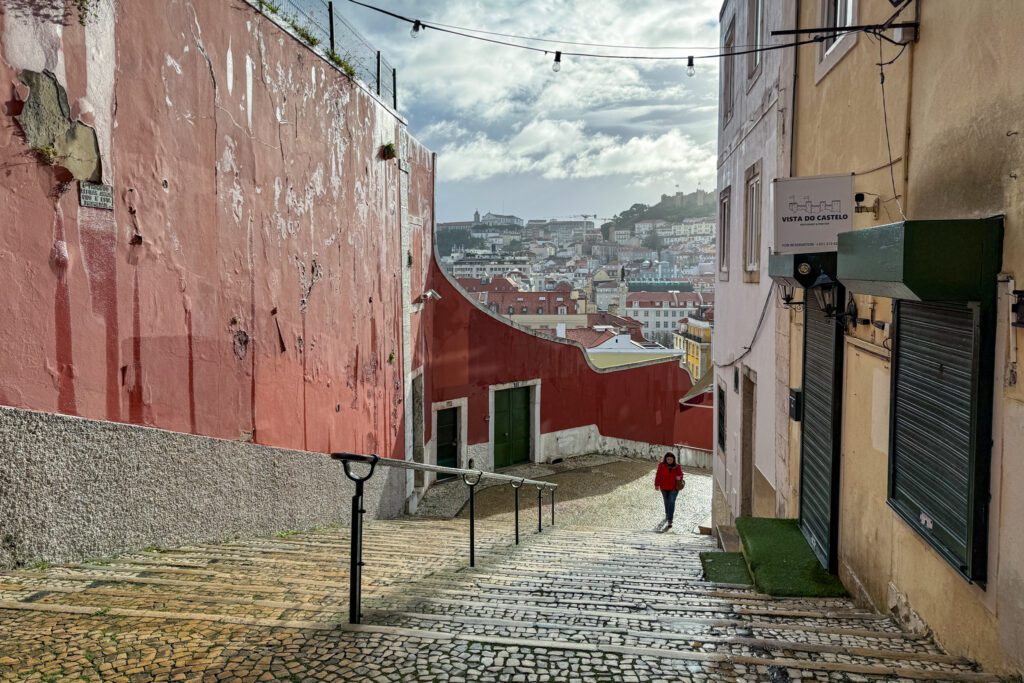
I really enjoyed it, and would recommend it as a nice introduction to Lisbon on your first day if you’re not looking for a private tour.
When we returned to Lisbon at the end of our first trip (which spanned three months across western Europe bookended by Portugal), we spent the better part of a week revisiting Lisbon on our own.
We were looking for a unique perspective on Lisbon, and stumbled across We Hate Tourism Tours, which is certainly a different take on Lisbon. We did their “A Walk in the Real City” tour and loved it.
If you’re looking for less of a history-focused tour and are more into the idea of talking about modern Lisbon and the challenges it’s facing, this is a great tour that will take you to a completely different part of Lisbon to see the city through the eyes of someone who has seen the changes Lisbon has recently gone through – some good, some bad – and will tackle them head on.
Lunch in Baixa
For lunch, we have two great options for you in Baixa, which as we’ll cover in the section immediately following this one, is the “downtown” area of central Lisbon. More on the history and evolution of this part of the city in a second. First let’s focus on the food.
There are two options here that we think are worth your time and they give you a slightly different take on Lisbon’s food scene too.
On one hand, you have a cheap sandwich that is a staple of Portuguese cuisine.
On the other, you have a more modern and cosmopolitan take on Lisbon’s food scene.
If you’re a group our recommendation would actually be to try both if you have the stomach.
The first option is to try a bifana, which is a traditional Portuguese sandwich consisting of a soft bread roll (not gluten free!) filled with thin slices of marinated pork and plenty of mustard and piri-piri sauce.
No one is quite sure of the origins of the dish, but today the sandwich is one of the most popular fast foods in Portugal.
In a traditional bifana, the pork is marinated and cooked in white wine, vinegar, garlic, paprika, and salt, though there are some regional variations that use different ingredients (like port in Porto).
There are two spots in Baixa that were recommended to me by tour guides and baristas – I like to ask “what is the one thing people should eat in Lisbon” – for their bifanas.
The first is As Bifanas do Afonso (here on Google Maps), which I have walked by multiple times before and taken note of the long line (don’t worry, it moves fast).
The second is O Trevo (here on Google Maps) which is a short walk west and up the hill (it’s technically in Chiado, but close enough).
The second option for lunch is a more modern take on Lisbon’s food scene, and that’s the Time Out Market.
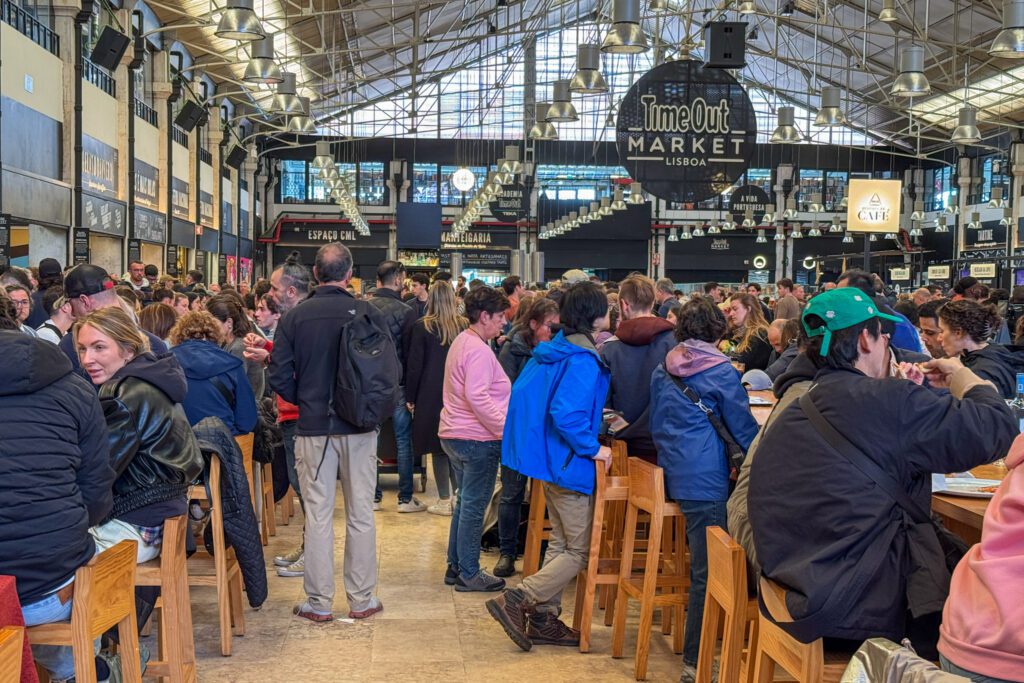
The background here is that Time Out (a travel brand) has been trying to get into experiential stuff, and one of the ways they’ve done that is to curate some of the best food in a city under one roof.
Lisbon is actually the first Time Out Market that ever came to be when the Lisbon-based editors for Time Out decided to try something.
In this case, it’s a food hall near the river with communal seating in the middle of a big open space, with the outer perimeter of the hall lined with food and drink vendors.
You’ll find some of Lisbon’s most famous chefs have outposts here, along with some lesser-known options ranging from sushi to pizza.
It kind of reminds us of food cart pods at home in Portland in that it’s a way for a group of people to try a bunch of different kinds of food in one spot.
Is it full of tourists? Yes, almost exclusively. Does that mean it’s not worth eating and drinking your way through the market? No.
Discover the Best Pastel de Nata in Lisbon
I’m almost certain that one of the first things you know about Portugal is that it’s the birthplace of the pastel de nata, a delicious little egg custard tart that has become extremely popular even outside of Portugal over the past few years.
We’ve even seen them start to show up here in Portland!
The legend goes that the pastel de nata was created by monks from a monastery in Belém wayyyy back in the early 19th Century.
And the story is actually fascinating, and completely plausible.
Next to the monastery, there was a sugarcane factory, and after the revolution in Portugal in 1820, all convents and monasteries were shuttered in 1834, which meant that the monks had nowhere to go, and no way to make a living.
Before that, they bought A TON of eggs (the whites were used for starching robes) and found themselves with some leftover egg yolks, so they started making sweet treats as a little bit of a side hustle (and probably, more importantly, to enjoy themselves).
Ever the entrepreneurs, they sold that recipe to the pastry shop – the same one that exists there today – using that handy dandy sugarcane factory and those eggs. Guess what the two main ingredients are in those pastries? Sugar and eggs.
They started pumping out these “Pastéis de Belém” – which would eventually become known more broadly as “Pastéis de Nata” – and two centuries later, the recipe and methods are said to be almost exactly the same as they were back in the 19th Century.
There are a nearly unlimited number of places to get a pastel de nata in Lisbon. As you might already know (or have guessed based on our name), Matt has Celiac Disease and can’t eat gluten, so his selection was very limited.
However, on that first trip to Lisbon, we were traveling with Matt’s two brothers, and between them and Alysha, we tried a fair amount of pastéis.
Lisbon is home to some of the best pastelarias (pastry shops) and tastiest pastéis (plural of pastel de nata) in the entire country.
We got three recommendations from locals when we asked about their favorite place to get pastéis de nata in Lisbon.
These were:
- Manteigaria. Popular bakery specializing in pastéis de nata, with two outlets in Chiado and Ribeira.
- Pastéis de Belém. The historic bakery in Belém is close to the Jerónimos Monastery where the sweet pastry is said to have been invented. This bakery serves the “original recipe” of pastéis de nata (allegedly).
- Pastelaria Aloma. Award-winning pastéis de nata bakery that dates back to 1943, now with multiple locations around Lisbon. A little harder to find, though, because their location in the center closed recently.
Lucky for you, Manteigaria has multiple locations in Baixa and Chiado. There’s actually one at the Time Out Market, but we’d head to their location in Chiado on Praça de Luís de Camões instead (here on Google Maps).
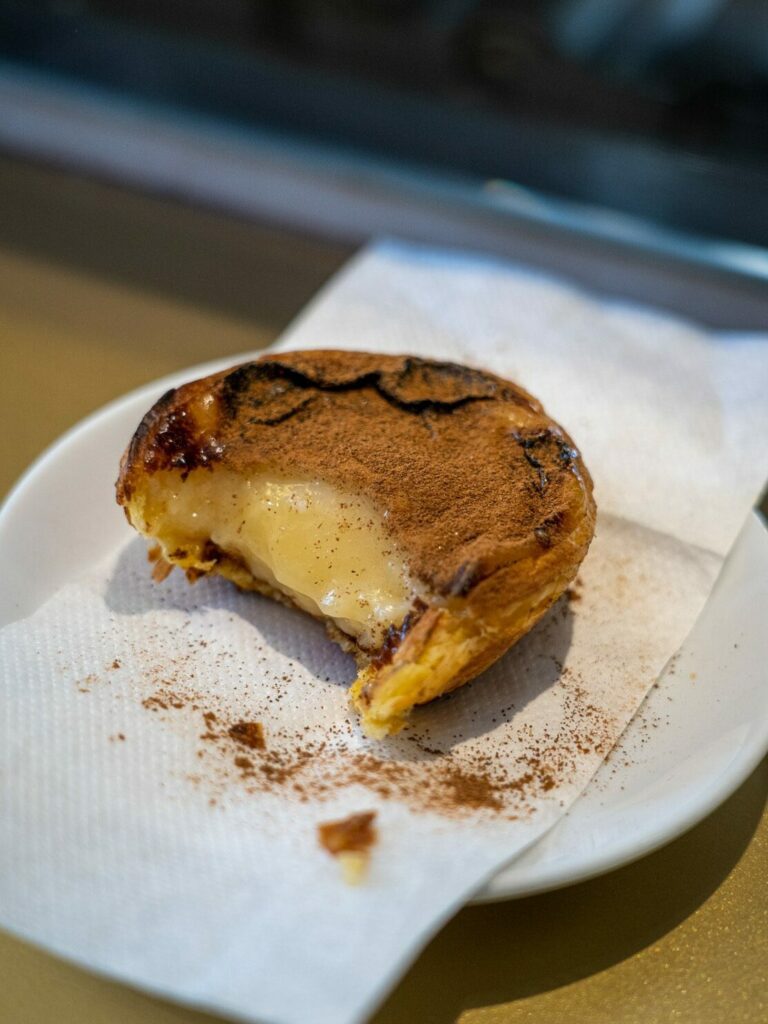

Pastéis de Belém is on the itinerary tomorrow, so you’ll have a chance to compare for yourself.
We tried all three to see which version we liked best and Manteigaria was the CLEAR winner.
However, we also found that they were all relatively close and that the more important factor than the specific bakery was whether or not the pastel was fresh and warm, which led to a much better, flakier experience with a nice texture contrast that just wasn’t the same when they were cold.
If you’re looking for the best gluten free pastel de nata in Lisbon, run (don’t walk) to Rice Me Deli (which won my taste test EASILY – more in my guide to gluten free Lisbon).
The point is that you should absolutely source recommendations from people you meet in Lisbon, and try them all for yourself to see which proprietor comes out on top for you.
Exploring Baixa + Chiado (and Bairro Alto!)
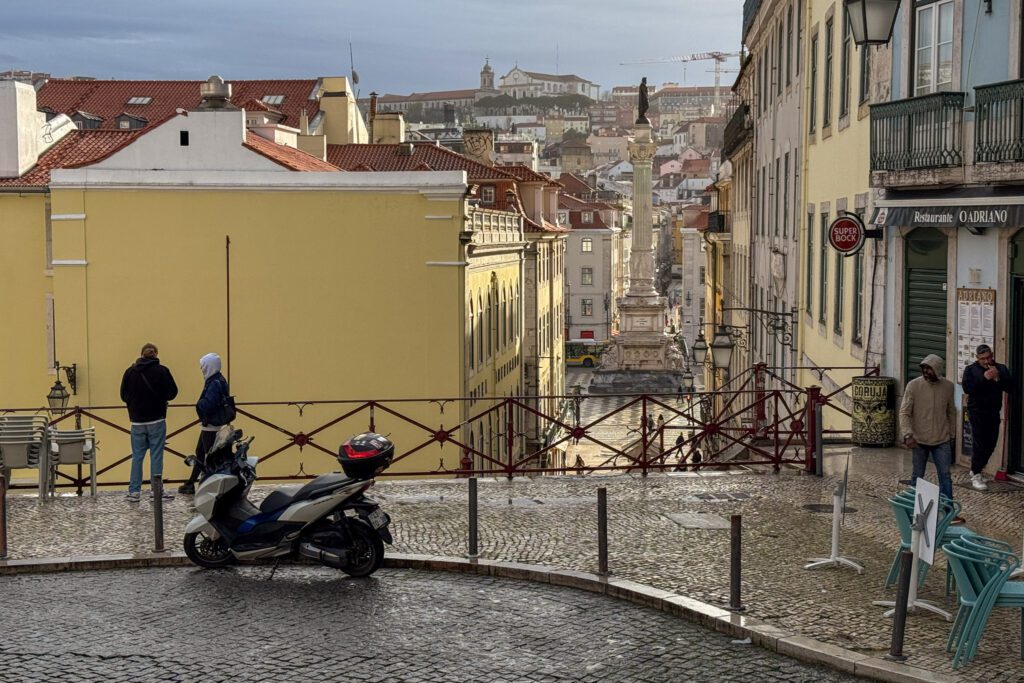
After lunch, strap on your walking shoes because the plan for the afternoon is to explore the two main hills in Lisbon.
Start with the hill you’re closest to, which is the one where you’ll find charming Chiado and lively Bairro Alto.
There are really two parts to this exploration, and it has to do with where you are relative to the hill.
Chiado is the area on the slopes of the hill, and is the part of the city that drew writers and other intellectuals (like Luís de Camões, the most famous Portuguese poet, who has a plaza in Chiado dedicated to him).
Today, it’s caught between the modernity of Baixa and the charm of Bairro Alto, and you’ll find some good shopping, some great views, and some important elements of Portuguese history.
Baixa is the “downtown” area at the base of the hill. One of the first things you’ll notice is that it’s on a modern grid, which is COMPLETELY different from the vast majority of Lisbon.
That’s because Baixa was the epicenter of that devastating earthquake in 1755 (and the resulting tsunamis and fires), and the vast majority of Baixa was destroyed.
At that point, Marquês de Pombal – who is a famous political figure who was somewhere between a mayor and a dictator – decided to pick up the pieces and create a more modern neighborhood that would not suffer the same fate during the next earthquake, with wider, more accessible streets and modern building codes.
Today, you have a neighborhood that feels simultaneously very ornate and also very modern, and it’s an interesting story of recovery and urban planning that you’ll probably hear about while you’re in Lisbon.
We’d organize your exploration by starting in Chiado (from the Praça de Luís de Camões) and making your way up to the top of the hill to Bairro Alto, and then working your way back down through Baixa.
There are a couple of ascensores (which are funiculars, kind of like a cable car) – you can find them here and here – that can help you climb the hill if you have mobility restrictions, but we’d recommend walking if you can because there are some great views to be had from random streets atop the hill.
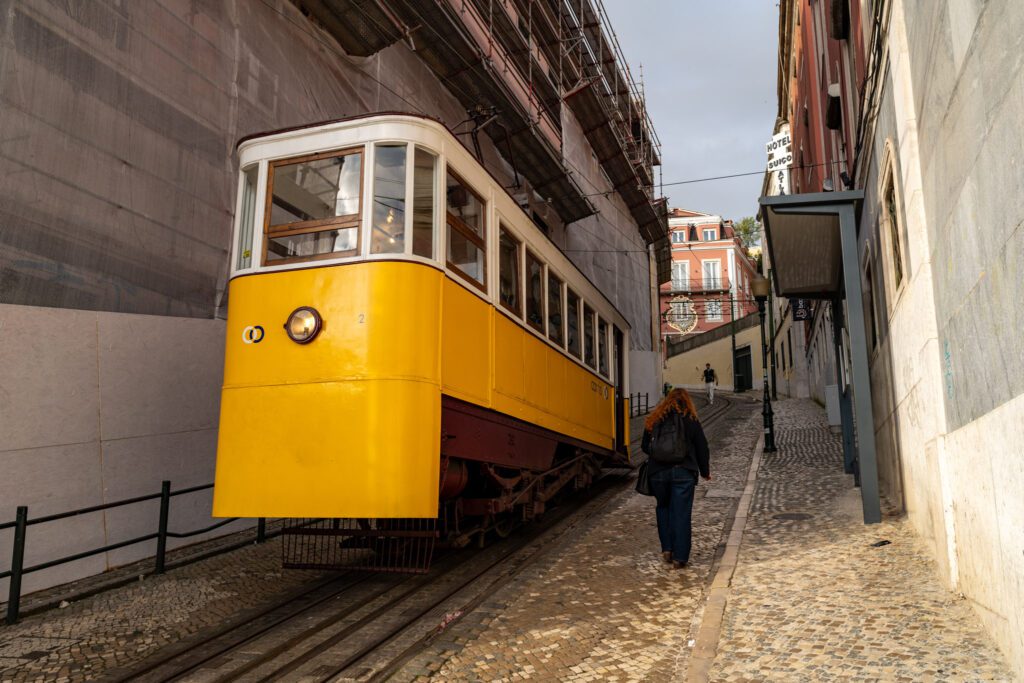
Something like this route would be a perfect start to an epic afternoon full of great views from Lisbon’s many hills.
Along the way, there are several stops worth making. Here are some of our favorites in the order you’ll encounter them if you follow our advice.
A Brasileira and Livraria Bertrand: Two relics of Portugal’s literary history. A Brasileira is a cafe that was the favored haunt of Lisbon’s famous intellectuals (there’s a statue of the famous poet Fernando Pessoa outside) that would be a great spot for a quick coffee. Livraria Bertrand is (allegedly) the oldest bookstore in the world.
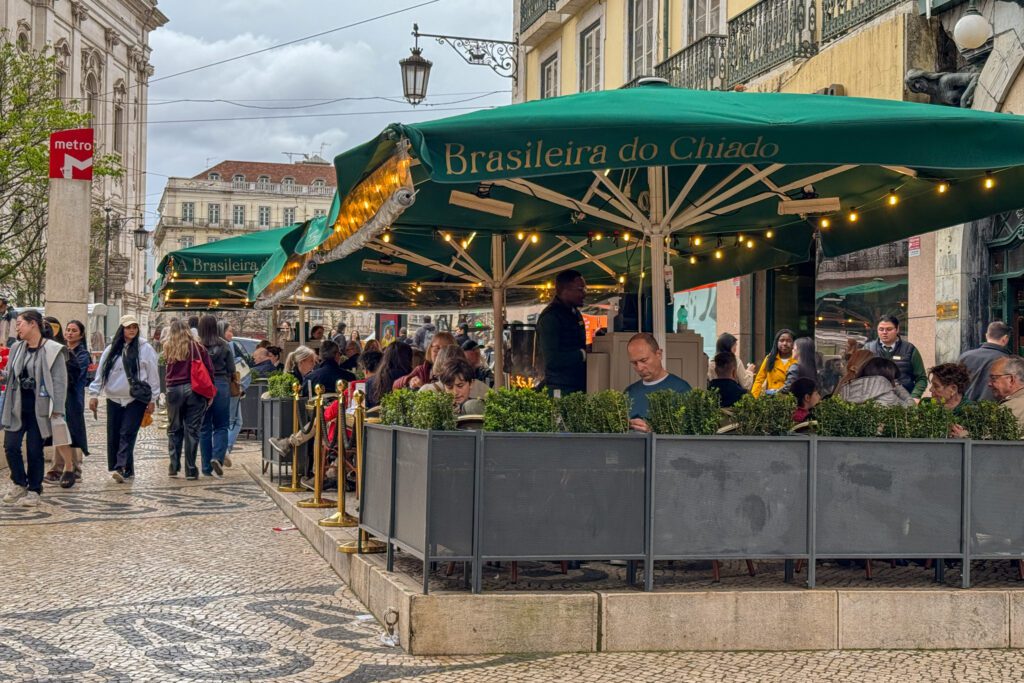
Elevador de Santa Justa: This cast iron elevator brings people from the streets of Baixa up the hill to Chiado, but the lines are long and it’s a short walk to cover that same ground. Our recommendation is actually to see it from the bottom, then walk around it up the hill and then see it from the top (or vice versa) rather than actually riding it. It features long lines and high prices, and this is a good way to save both time and money.
Convento do Carmo: It’s not worth going inside, I think (it’s just a big collection of artifacts with very limited storytelling or even relation to the building itself) but it’s a reminder of the devastation that hit Lisbon in 1755. The square outside is also the location of the culmination of the Carnation Revolution that (peacefully) ended the Salazar dictatorship and brought democracy back to Portugal (the headquarters of the equivalent of the National Guard is next to the convent).
Miradouro de São Pedro de Alcântara: A nice view out to the northeast where you’ll find a great view that is more accessible from central Lisbon and also has a nice little guide to the various hills and landmarks you can see. Spoiler alert: you’ll be seeing this point from the hill across the valley later in the evening!
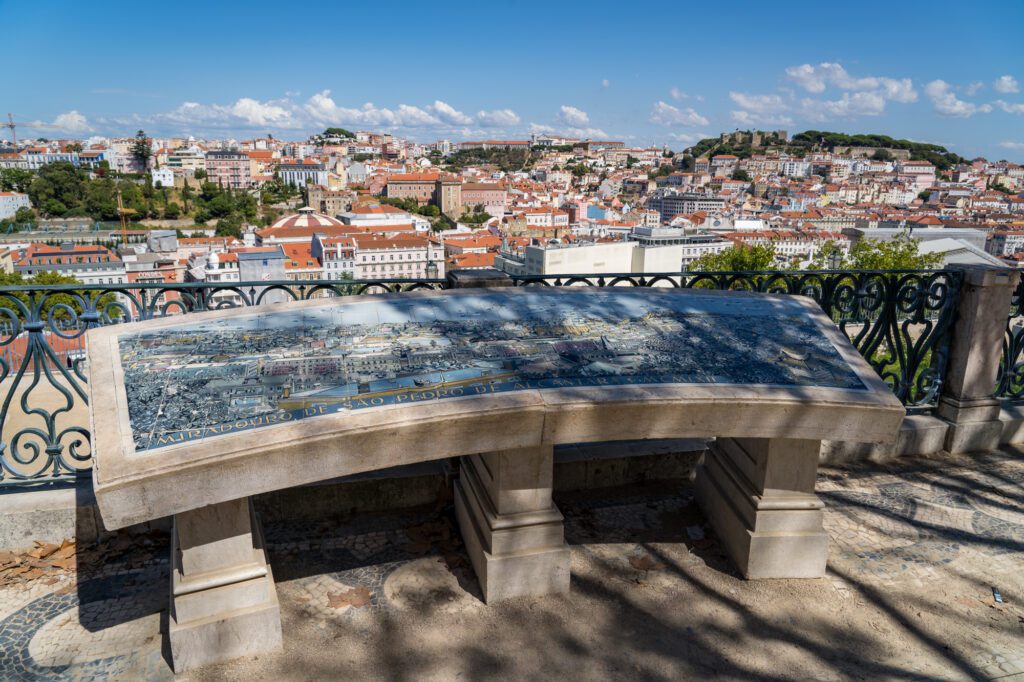
Jardim do Príncipe Real: The top of the hill! Or close to it. I met Humberto, my guide for the LisboaLove walk I did on my last trip to Lisbon, here. As I was waiting for him, I was enamored by the views from the streets at the south end of the garden and the massive cypress tree with an elaborate trellis supporting it.
From here, we’d recommend walking down the hill past Praça da Alegria (here on Google Maps) to meet up with the broad boulevard that runs through the center of the city, Avenida da Liberdade. Follow that to Rossio Square, where you can start your exploration of Baixa.
If you’re looking for coffee, stop at Dramático (here on Google Maps) which was my favorite coffee shop in Lisbon on my last visit.
From Rossio Square, walk down to Praça do Comércio. Make sure to check out the Santa Justa lift from the bottom, and also walk through the Arco da Rua Augusta, Lisbon’s triumphal arch (every city has one!).
An Afternoon Exploring Alfama
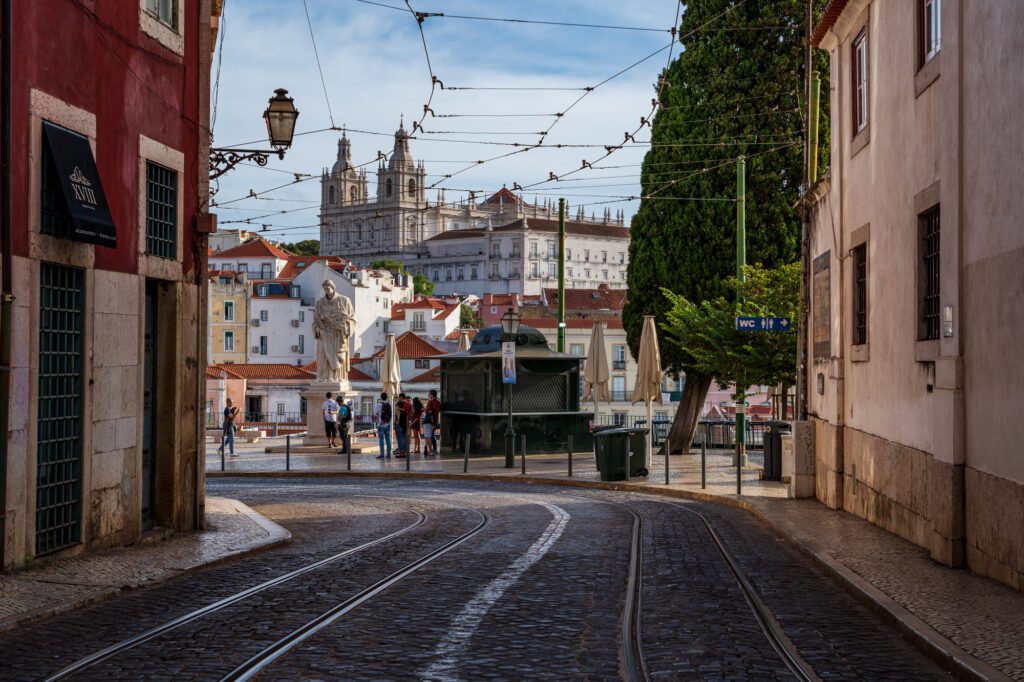
After lunch and doing a bit of poking around in Chiado, head to the most romantic part of the city, Alfama.
Alfama is the oldest feeling part of the city, with narrow cobblestone streets that wind their way down from the Castelo de São Jorge at the crown of the hill. It’s also home to several of the best viewpoints in all of Lisbon, which you should definitely make an effort to get to.
Here are a few suggestions of things to do and see in Alfama. My advice is to start near the top of the hill with the castle, then make your way downhill from there to the Lisbon Cathedral (Sé de Lisboa).
You can ride the 28 tram up the hill and walk back down if climbing up to the castelo on your own two feet doesn’t sound like your idea of fun.
One note: Your next stop is actually further up the hill from the miradouros (to another miradouro and some pre-dinner drinks), so plan on heading uphill from the miradouros. It’s a little bit of backtracking, but we think it’s worth it for one of the best views in all of Lisbon.
Castelo de São Jorge: The castelo sits on top of the hill, with Alfama sprawling down the hill from its walls towards the river. It used to be an important defensive position, and was the scene of many battles over the centuries before the Portuguese took Lisbon and established it as their capital.
Since then, it has been many things, including a hospital and a prison, and only in the 20th Century was it restored to its former glory. Today, you can visit the grounds (it costs 10 Euros) and, most importantly, walk on the castle walls for some amazing views.
Miradouros Galore: There are several great viewpoints in Alfama, including two that are just a few blocks away from each other.
Miradouro de Santa Luzia (here on Google Maps) is the first, and it’s a nice view out towards the river. There are some cool tiles to check out on the side of the Igreja de Santa Luzia (right next to the viewpoint) depicting a battle for the Castelo.
The second is Miradouro das Portas do Sol (on Google Maps here), which has even better views out towards the Tagus River, including the Igreja de São Vicente de Fora out to the northeast on the hill.
Don’t miss the statue of St. Vincent, the patron saint of Lisbon. The latter viewpoint has a nice little outdoor terrace with a bar, which would be a lovely place to enjoy, say, an Aperol Spritz or a Port Tonic while watching the sun’s golden glow light up the hillside.
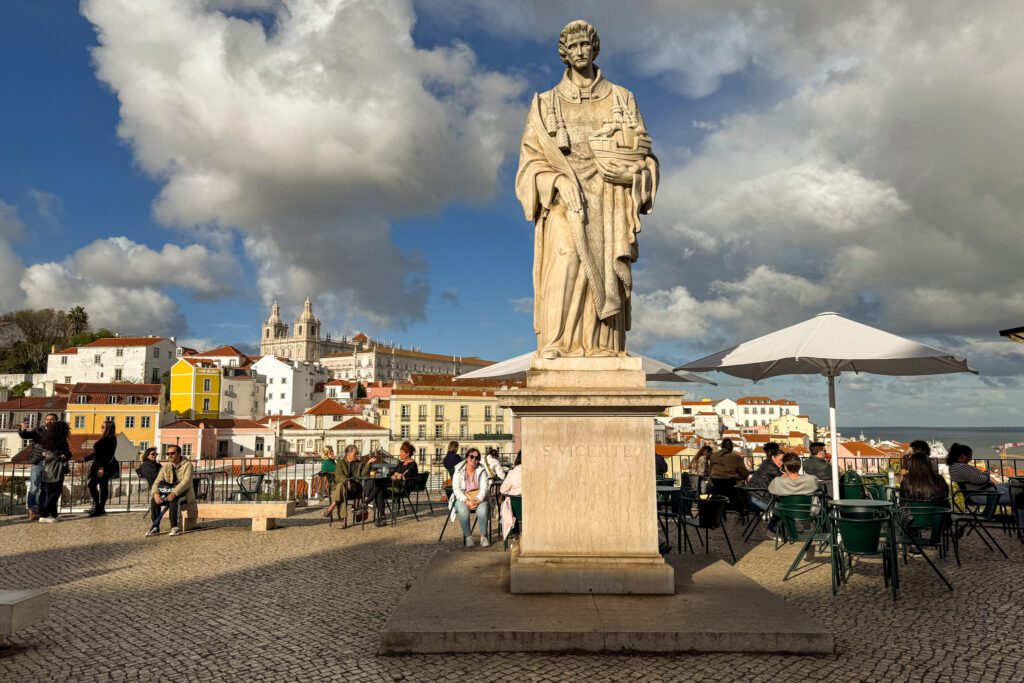
Miss Can: When in Lisbon, you should try canned fish at least once, even if you’re not sure it’s your thing. And we think Miss Can is the place to do it.
It’s owned by a woman whose family has been in the fishing industry for generations, and she does the work to ensure her product is sustainable, from the fish to the cans.
We tried a bunch, and really, really liked the bacalhau (that’s cod) in garlic and olive oil. It was the least “fishy” option if you’re not a huge fan of fish flavors.
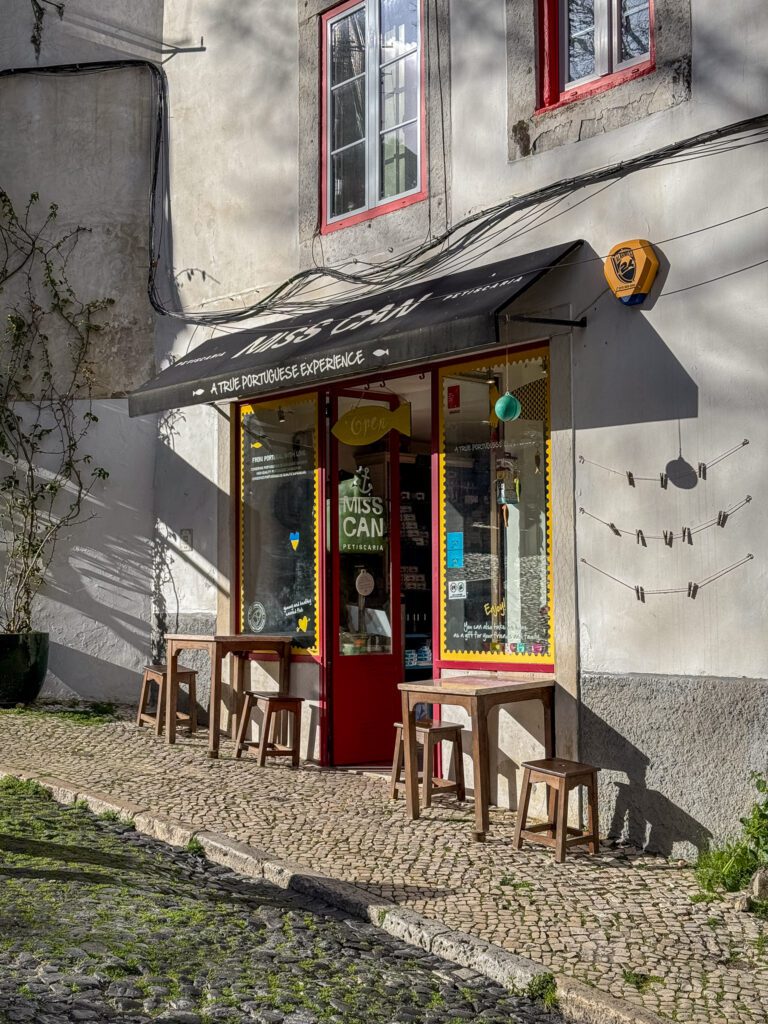
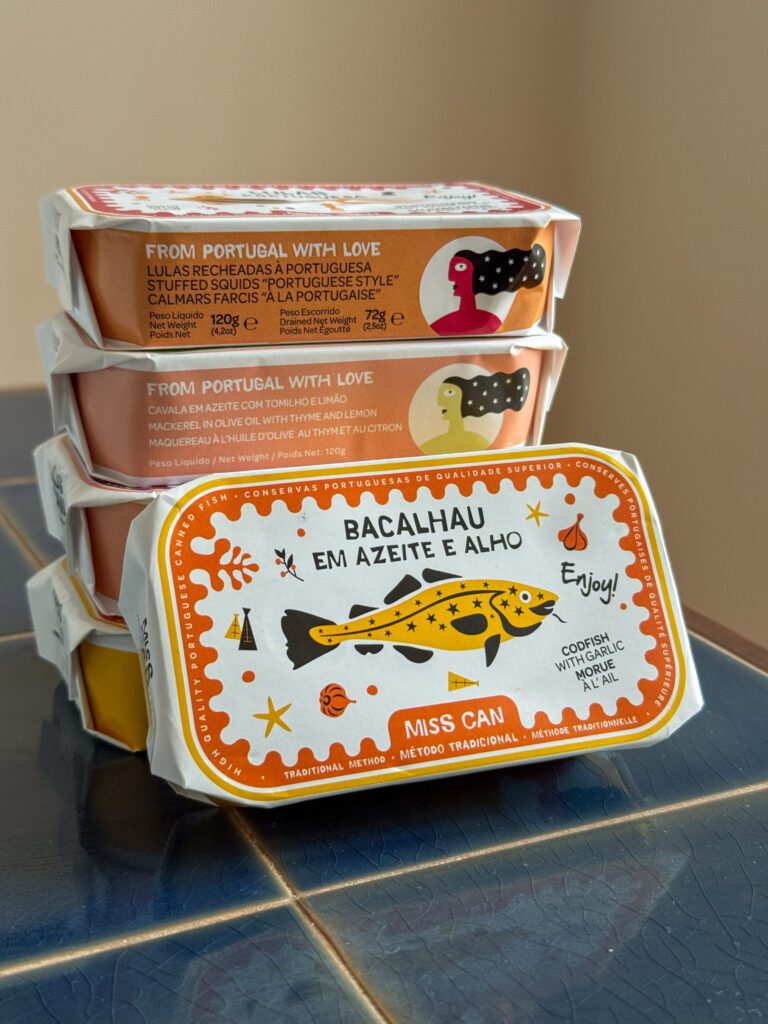
You can either enjoy it at the small restaurant, or pick up some cans to try later. They also make great souvenirs to bring home for friends and family.
On our return trip to Lisbon a few months after our first visit, we came back and bought about seven cans to bring home to friends, all of whom absolutely loved them (and some even ordered their own to ship all the way to the United States).
Pre-Dinner Drinks in Graça + Dinner Back Down the Hill
Rather than head down the hill after doing some exploring of Alfama, make your way to nearby Graça to get some drinks before dinner in Alfama on your journey back down the hill.
First, head up to take in what might be the best view in all of Lisbon at Miradouro da Senhora do Monte. Fair warning, it’s quite the hike, but it’s worth it (here on Google Maps).
Here’s the view.
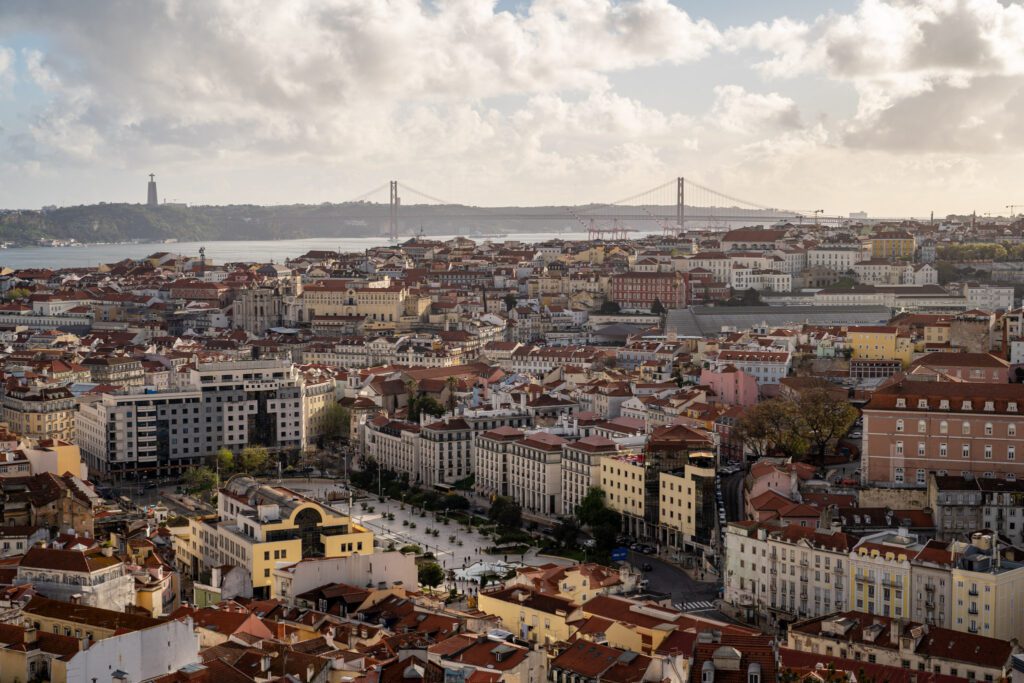
From there, make your way back down the hill through Alfama.
Near the viewpoint, check out either 8a Graca for some of the best craft beer in Lisbon, or down the hill to Graça do Vinho for an extensive selection of Portuguese wines and some light snacks (think bread and cheese).
On the way back down through Alfama, there’s a nice viewpoint called Miradouro da Graça (here on Google Maps) where you’ll find a nice terrace with a view of the Castelo, which would be a great place to grab a drink before or after your journey up to the viewpoint mentioned above.
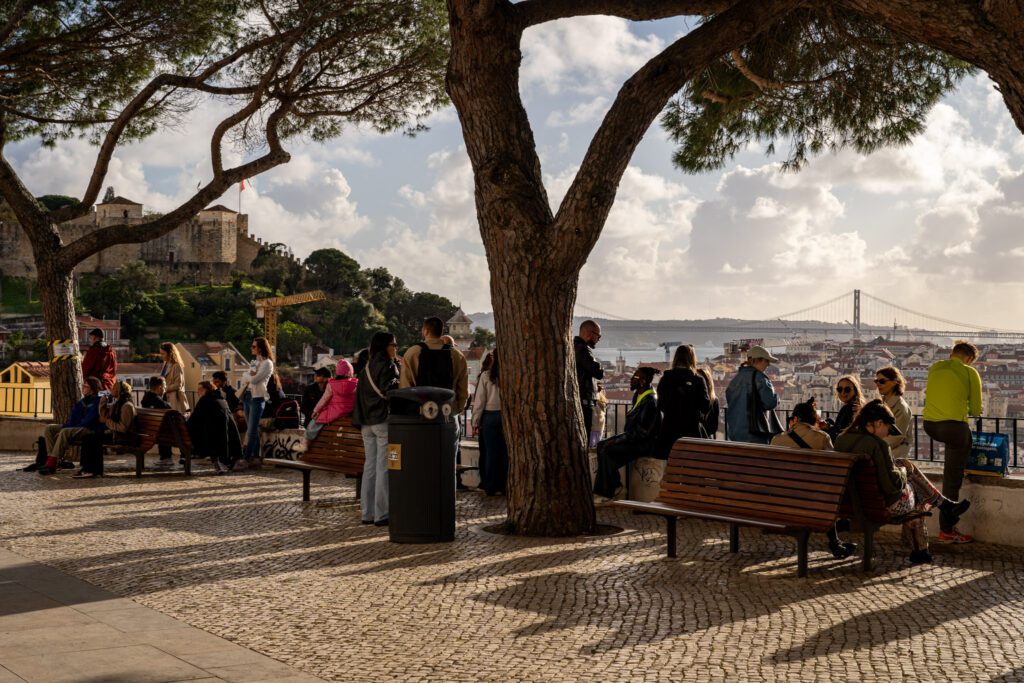
For dinner, there are A LOT of very touristy, very overpriced restaurants in Alfama, as our walking tour guide warned us. If you choose one of those, you’ll pay for the atmosphere, and the food won’t be great.
One place that we wanted to call out because it was recommended to us so many times is Cervejeria Ramiro – a seafood spot a short journey from Baixa (or on the way down from the miradouros) that was recommended to us by three separate Lisboans.
It’s popular, so be prepared to wait in line, but multiple people who live in Lisbon told us it’s one of their favorite places to eat in the city. We’d make a reservation in advance if you want to eat here.
Alfama Cellar is another place that was recommended to me partially because they can do gluten free food, but their seafood rice (in my mind, the Portuguese version of paella, ish) is the thing to try.
Day 2: Dive into Lisbon’s Food Culture + Belém
On your second day in Lisbon, head out west to Belém for a morning of exploring Portugal’s maritime history.
Back in central Lisbon, dive deeper into Lisbon’s food culture (which is almost always a window into a place’s history) and end your day out on the water.
A Morning in Belém
For the morning, we’d head out bright and early to beat the crowds to Belém.
Belém used to be a separate city, but as Lisbon has expanded it has swallowed it up and now it’s a district within the broader city of Lisbon.
It’s right along the river, and is home to several cool sights, including the Torre de Belém, a huge monastery, and, perhaps the most important, Pastéis de Belém, which is said to be the birthplace of the original pastel de nata.
Today, the entirety of Belém is a UNESCO World Heritage Site.
In Belém, we’d recommend starting at the furthest end with the Tower of Belém, then working your way back towards Lisbon.
Getting to Belém: The easiest way to get there from the center of Lisbon is to hop on the 15E Tram from around Praça do Comércio. It takes about half an hour each way, and costs three Euros in either direction. You can buy tickets on the tram, but you have to use the machines which sometimes don’t work (they do accept credit cards now though!).
Torre de Belém
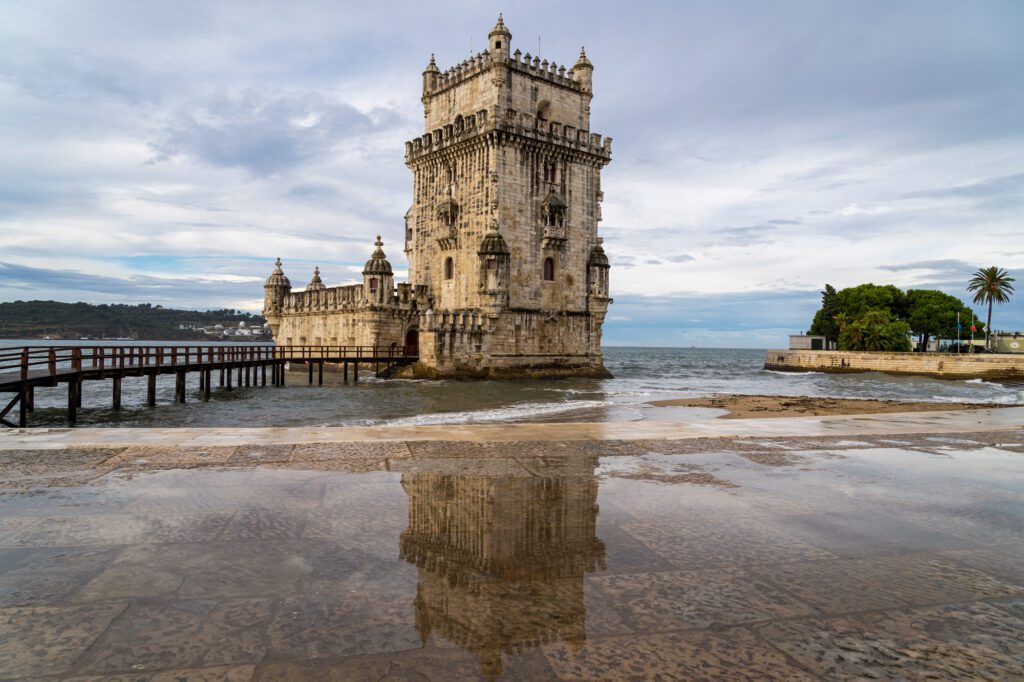
First of all, don’t go up into the tower. We just saved you €15 a person. Lines are long, and the view from the top isn’t really worth the money or the time it’ll take you to get there.
It is, however, worth admiring from the outside because it’s a beautiful building.
It was built in the 1500’s for two reasons – to serve as an entry / exit point for people coming in and out of the city by ship, and to serve as a coastal defense for Lisbon, as it’s ideally placed along the banks of the river near the mouth to fend off any attacks.
Unfortunately, it didn’t do so well on the second front.
It was taken in 1580 by the Spanish. But it was upgraded following that catastrophe, largely living out its days as a prison until it was made a UNESCO World Heritage Site in the 1980’s.
More information on the tower, including tickets, here.
Padrão dos Descobrimentos
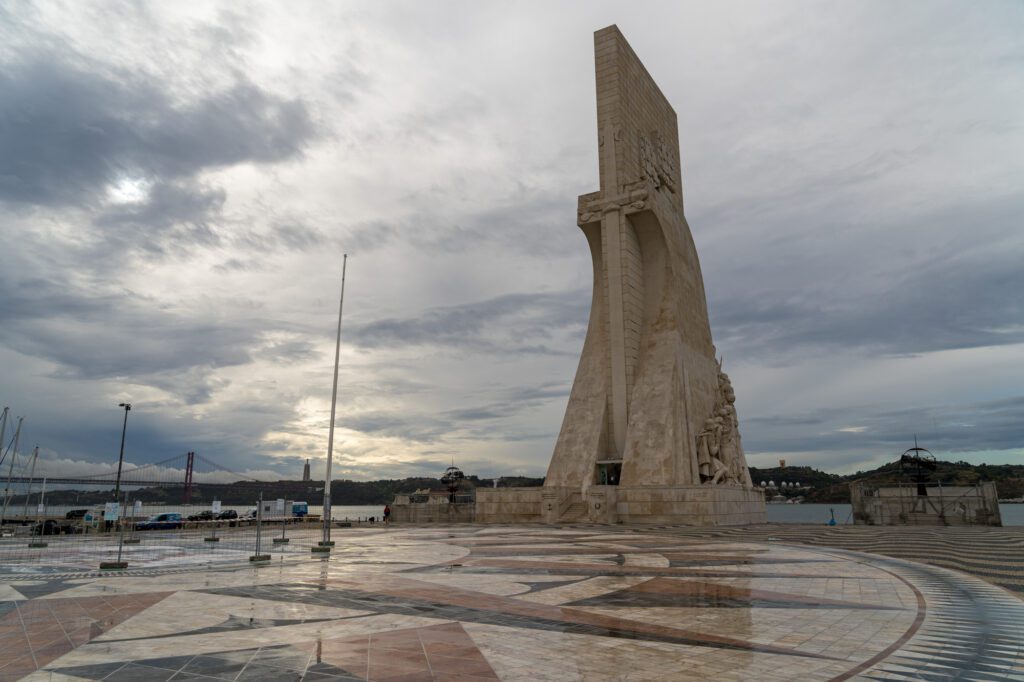
Wander along the waterfront heading east to the Monument of the Discoveries (in Portuguese, Padrão dos Descobrimentos), which is a tribute to Portugal’s amazing history of explorers.
Do you remember from fourth grade who the first person to travel around the horn of Africa over to India was?
I didn’t, but our walking tour guide was quick to remind me that it was Vasco da Gama, and we actually visited the town where he was born just outside of Porto later in our trip to Portugal.
That connection with Asia and the trade it brought to Portugal was a major reason for the rise of Portugal as an influential nation on the world stage during the Portuguese Golden Age (the 15th and 16th Centuries).
Vasco da Gama is one of the figures featured in the depiction on the side of the monument, which was built in the middle of the 20th Century under Portugal’s dictator, António de Oliveira Salazar, who was really into romanticizing Portuguese history.
Naturally, the Age of Discovery in the 15th and 16th Century was near the top of the “aren’t the Portuguese people great?” list, which is problematic because let’s be real for a second – all of the places they “discovered” were… already discovered. Just not by people with a specific shade of skin.
We’re not going to solve that issue here, so I digress.
Anyway, the square in front of the monument is beautiful, with art made from limestone tile donated by South Africa, and the towering monument that rises 171 feet over the river.
You can go inside, but we’d skip it, and instead just admire it from the outside.
Igreja de Santa Maria de Belém & Jerónimos Monastery
The big church you see from the tram is your next stop on your tour-de-Belém.
There are two pieces to this complex – the Igreja de Santa Maria de Belém (the church), which is free to enter and houses the tombs of Vasco da Gama and Luís de Camões, and the Jerónimos Monastery, which costs money and houses the beautiful cloister.
Construction started in 1501 and took over 100 years to complete, which should tell you something about the grandness you’re about to witness.
It’s a great example of typical Late Gothic Manueline architecture in Lisbon, which was created in the 16th Century during the Age of Discovery, and incorporates maritime symbols – ships, shells, and seas – into the more traditional Gothic style.
It’s typical in Lisbon, and there are a bunch of statues and examples of it around the city, including the statue of St. Vincent in Alfama, who is the patron saint of Lisbon and is holding a ship with two ravens, which is the coat of arms of Libson.
Like I said, elements alluding to the maritime history of Portugal all over the place.
The church is free to enter, and you should definitely peek inside to see the grand scale and the two tombs.
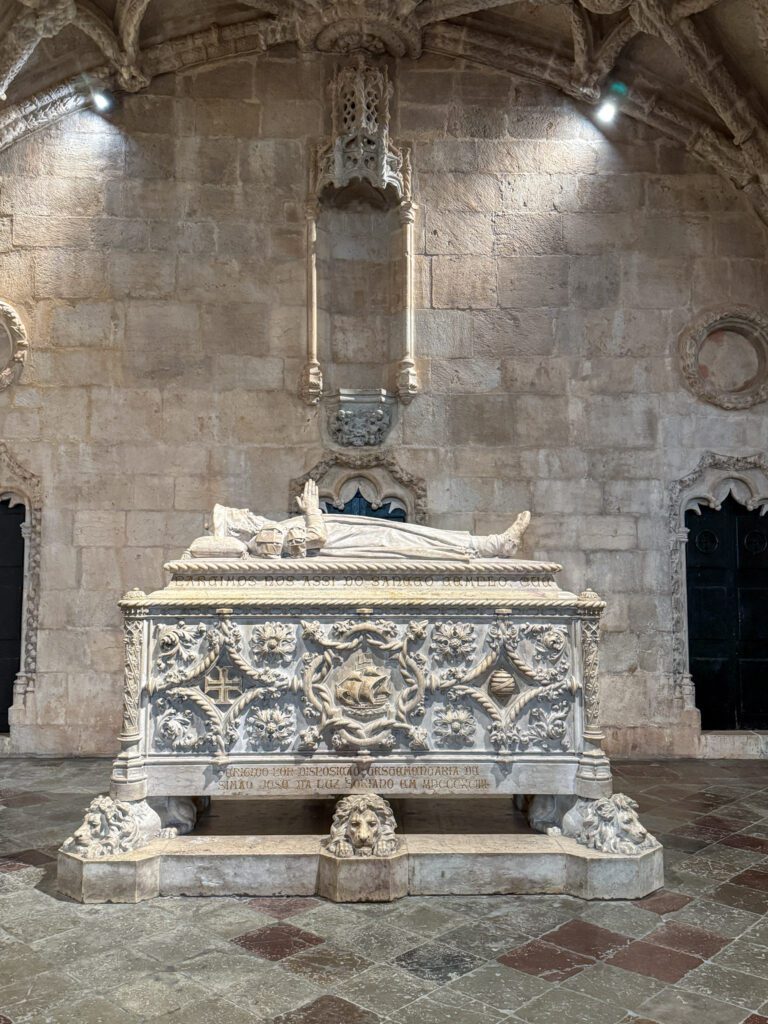
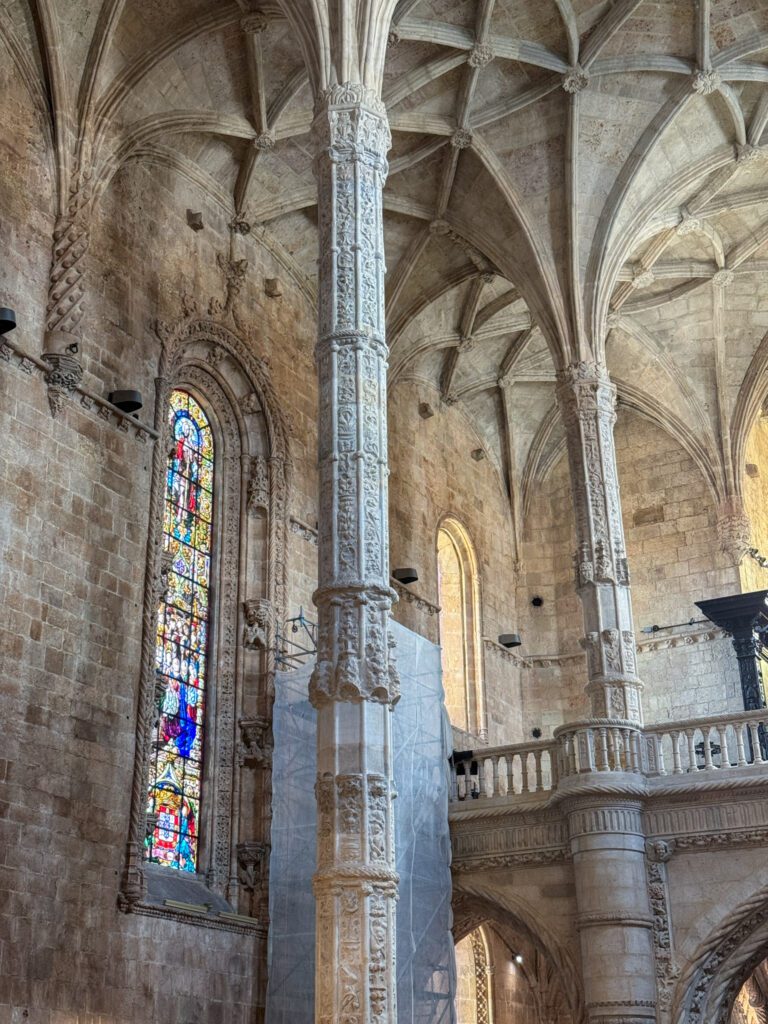
The cloister of the monastery is not free to enter – it costs €18, which is fairly pricey – but we do think it’s a cool illustration of the unique architecture you’ll find in Lisbon.
Until my latest trip to Lisbon, I had not been inside the cloister of the Jerónimos Monastery, which costs money to enter.
On this latest trip, it was one of the main things I wanted to do while I was in Lisbon, and it did not disappoint.
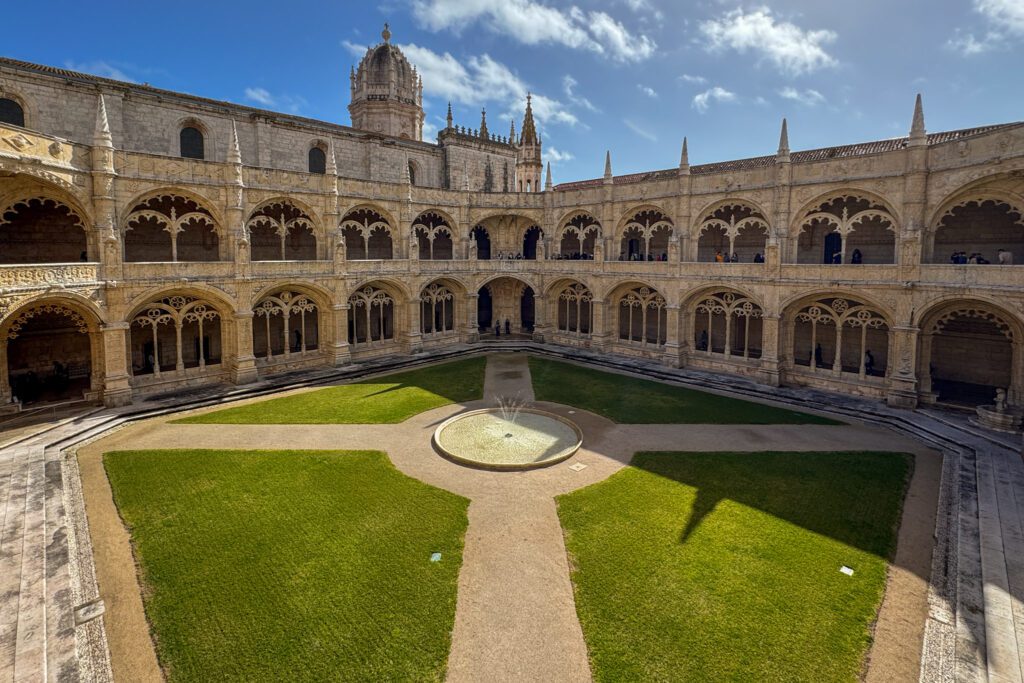
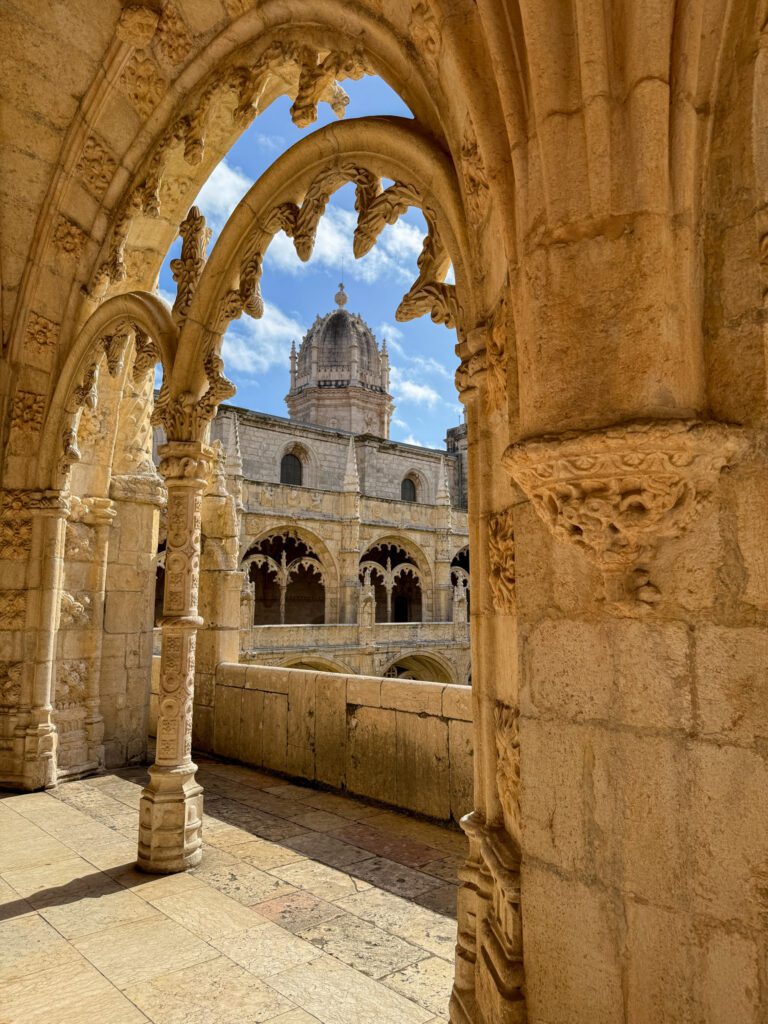
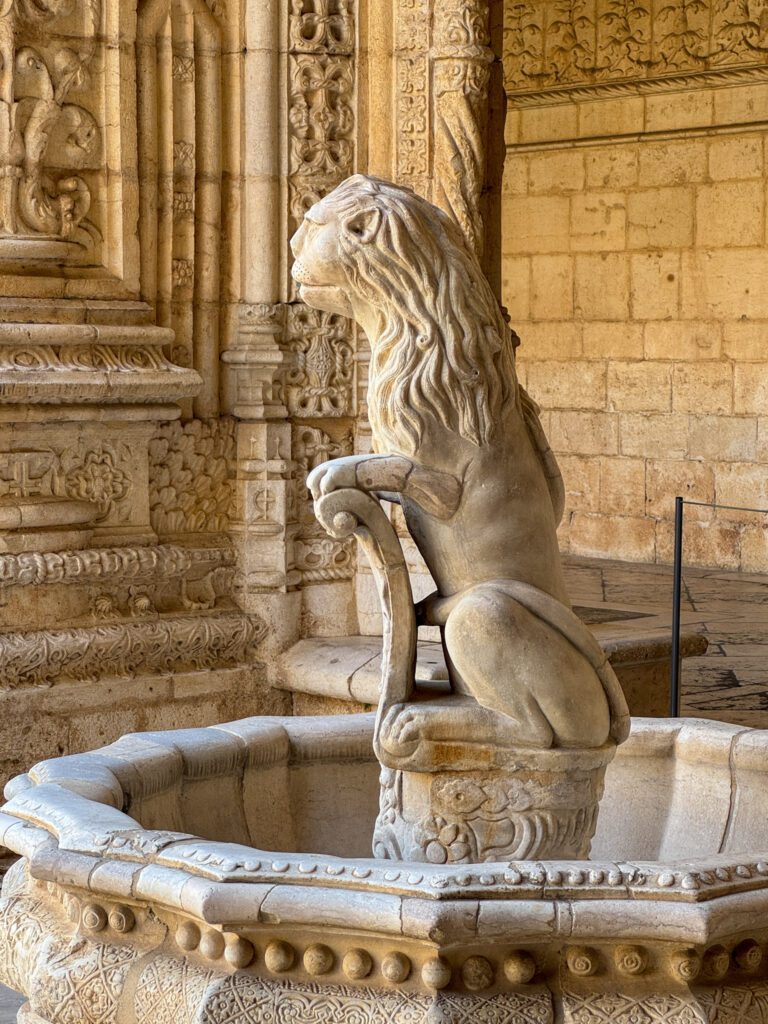
However, depending on your interests, this might be something you choose to skip. The architecture is pretty cool, but if churches and architecture aren’t your thing, then I can see how you might walk away disappointed.
If you do want to visit the cloister, I highly recommend booking tickets – which means choosing a timeslot – in advance to skip the long line at the ticket office.
I actually had to come back a couple of days later because I thought “I’ll just show up and wait” only to find a LONG line snaking around the complex (I left, bought tickets for a couple of days later, and came back and walked right in with my pre-purchased ticket).
More information, including tickets, can be found here.
Pastéis de Belém
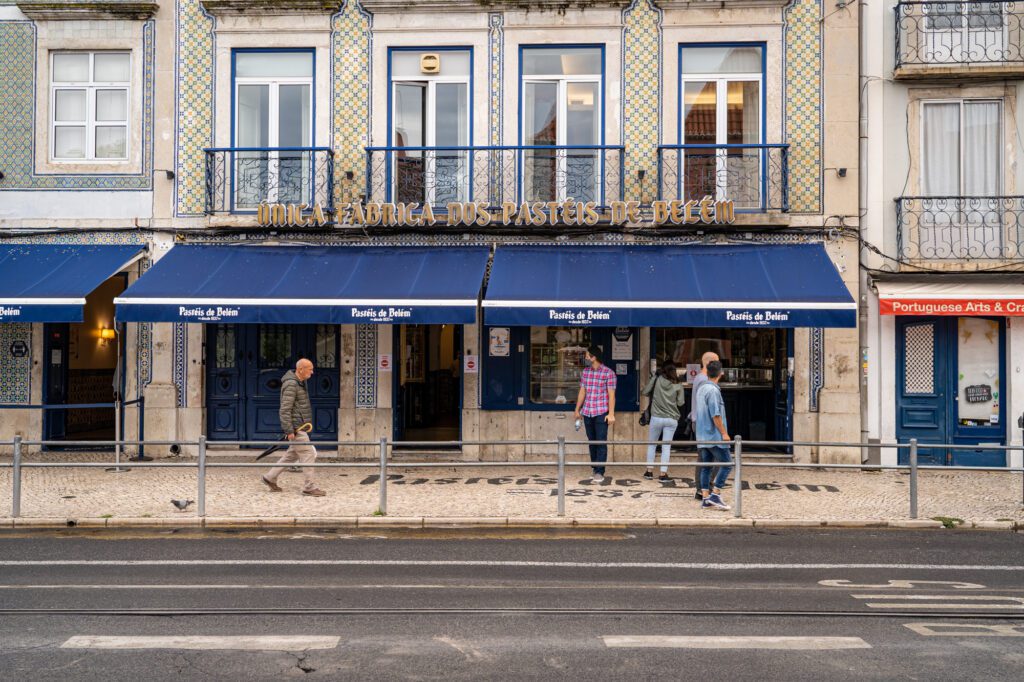
Head about a block east from the monastery to your final stop in Belém – the birthplace of the pastel de nata. Allegedly, anyway.
The legend goes that the pastel de nata was created by monks from the monastery wayyyy back in the early 19th Century. And the story is actually fascinating, and completely plausible.
Next to the monastery, there was a sugarcane factory, and after the revolution in Portugal in 1820, all convents and monasteries were shuttered in 1834, which meant that the monks had nowhere to go, and no way to make a living.
Before that, they bought A TON of eggs (the whites were used for starching robes) and found themselves with some leftover egg yolks, so they started making sweet treats as a little bit of a side hustle (and probably, more importantly, to enjoy themselves).
Ever the entrepreneurs, they sold that recipe to the pastry shop – the same one that exists there today – using that handy dandy sugarcane factory and those eggs.
Guess what the two main ingredients are in those pastries? Sugar and eggs.
They started pumping out these “Pastéis de Belém” – which would eventually become known more broadly as “Pastéis de Nata” – and two centuries later, the recipe and methods are said to be almost exactly the same as they were back in the 19th Century.
They’re so serious about their brand that only the pastéis that come out of this kitchen can legally be called “Pastéis de Belém” – the original.
Part of me wonders how much of that story has been romanticized over the years, and how similar the recipes really are today.
The other part of me says “yeah, that’s a good story, let’s go with that.” But are they really the best? Here’s a completely subjective and unscientific take.
Everyone says to go here for the best pastel de nata you’ll have in Lisbon. So we put it to the test. And by “we” I really mean my two brothers and Alysha. No gluten for me.
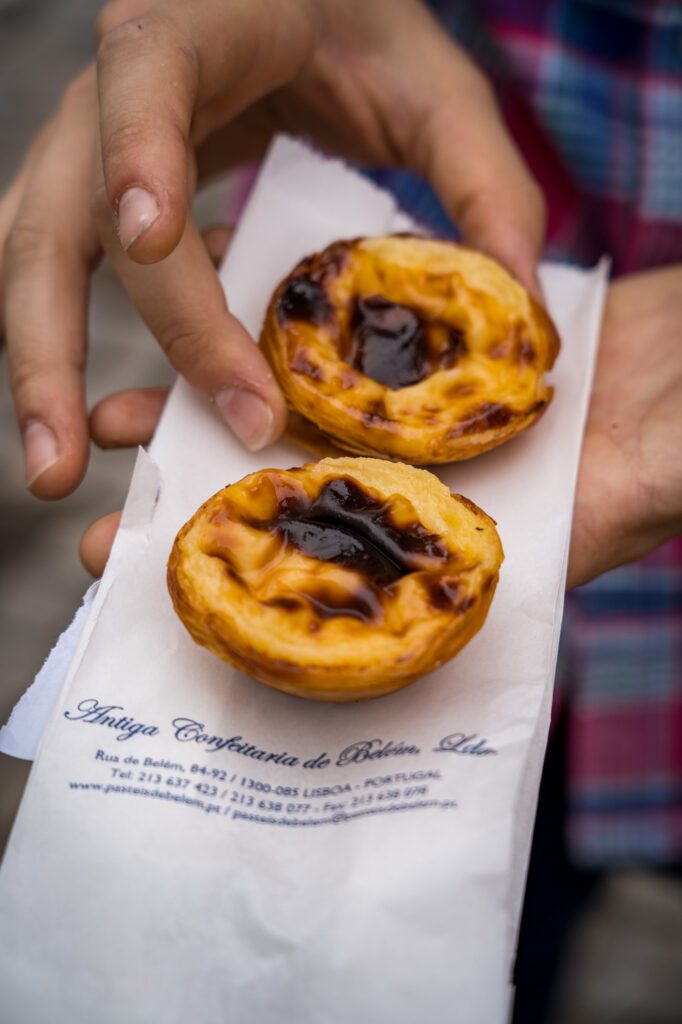

The results? This one came in second behind Manteigaria.
The crust was the best out of the three we tried, giving the pastry a nice texture contrast between the crispy outside and the ooey-gooey custard, but the custard was the downfall here, which was less flavorful than the ones they had tried previously.
Still, well worth a stop when you’re nearby. The more cinnamon, the better.
LX Factory
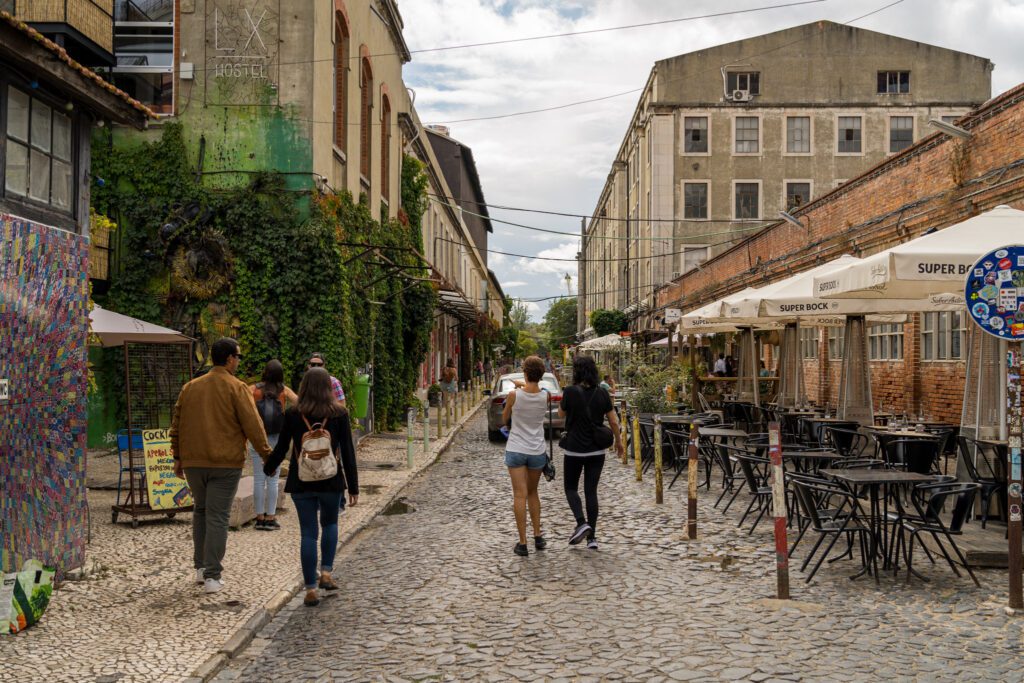
On your way back to the heart of Lisbon, make a pit stop in Alcântara to check out LX Factory, which is essentially right on the 15E tram line that you’ll take to and from Belém.
When you walk through the entryway here, you might feel like you’re in a hip part of Los Angeles or Brooklyn. And that’s kind of the vibe they’re going for, if we had to guess.
In the mid 19th Century, this area was home to an important textile factory. Which, as you might imagine, eventually shuttered thanks to globalization.
Today, it’s an outdoor hub of different shops, bars and restaurants, and small businesses who have all come together to create one of the most engaging, creative, and unique places in the entire city.
You’ll find a nice bookstore, a great wine shop, countless restaurants, and plenty more. Here were some of our favorite stops (though we think you should take your time and explore for yourself).
- Livraria Ler Devagar: You’ve probably seen this one on Instagram, with the big art fixture hanging from the ceiling of a person on a bike with their scarf trailing behind them. It’s a huge bookstore with a small English language section, a record shop on the first floor (that’s the second floor, to us Americans), and some cool old printing presses on the top floor that are worth checking out.
- More Than Wine: We found both wine and cider that we liked here, but they also sell things like chocolate, jam, honey, and ceramics.
We visited LX Factory in the morning, which we realized was not the right time to be there, and we ended up thinking to ourselves “I bet this place would be cool later.”
Dive into Lisbon’s Food Culture: Choose Your Own Adventure
In the afternoon, spend a few hours learning more about Lisbon and its history by…eating?
Diving into the food culture in places we’re visiting is one of our favorite aspects of traveling, and we try to include a food tour, cooking class, or market tour in most places we visit.
The food of a place tells you so much about the culture, history, and influences that have shaped the city you’re exploring today, and exploring a city through its food scene is a unique perspective that a lot of people don’t even consider.
Unfortunately, the reality is that because Matt has Celiac Disease and can’t have even a speck of gluten without being sick for days, a food tour or cooking class usually isn’t in the cards for us.
HOWEVER. That does NOT mean it shouldn’t be for you! We’d highly recommend it because it gives you a local’s perspective on the city’s food scene – what and where to eat and drink – and you get to connect with fellow travelers and try some amazing food.
Here are some options for you – one food tour and one cooking class – that have been on our list but can’t accommodate Matt’s gluten-related needs. Our bias is to do a cooking class, because we LOVE to cook, but we also enjoy a good food tour.
If you want to do a food tour, this is the tour we’d recommend, though (disclaimer) we haven’t done it ourselves. It’s a four hour journey through Alfama with 18 tastings over many stops as you make your way through the most charming neighborhood in Lisbon (we think).
Catch the 3pm tour and show up hungry. Seriously. Don’t eat beforehand.
If you want to do a cooking class, there are several directions you could go; focusing on a specific item (in this case, it’s the pastel de nata) or focusing on a broader look at Portuguese cuisine.
Depending on what you’re looking for, we had bookmarked these two tours for our own trip (though obviously the pastel de nata class is problematic for the whole gluten thing): this class focused on pastéis de nata or this cooking class that focuses more on main dishes.
See the City from the River at Sunset
Look, I too was skeptical of boat trips catering to tourists.
However, after a (life-changing, sort of) early morning canal cruise in Amsterdam – another city whose history is intrinsically linked with water – I have come around to the idea that it is absolutely worth seeing a city that is shaped by water from that water.
In this case, the water that shaped Lisbon is the Tagus River (also called the Tejo), which serves as its connection to the Atlantic and was the lifeblood of Portugal’s economy for centuries.
There are a wide variety of different river cruises available, ranging from bigger boats with DJs and bottomless drinks to smaller sailboats with more intimate groups, and as we were researching options we were drawn to the latter category.
There are a couple of tour options that we came across, and the key to look for is that you get a sunset tour run by a small Portuguese-run company, which will give you the best experience and help you see the city through a different perspective, both literally and philosophically.
The option that came to the top as we were searching is this sunset sailboat cruise, which is a small group (max of 10), is run by a group of Portuguese sailors, and covers a nice little loop out on the river.
Day 3: A Day Trip to Sintra
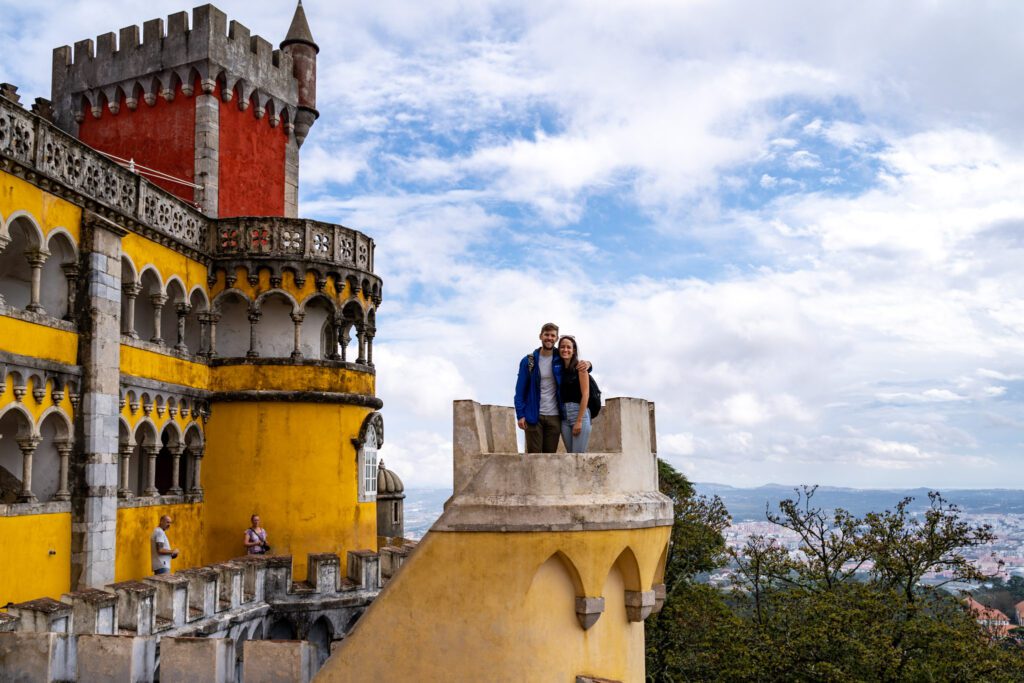
On your third day in Lisbon, we’d spend the majority of your day outside of the city exploring Sintra, the location of the summer palace (Pena Palace) along with a nice group of other attractions to see.
We have an entire guide dedicated to planning your day trip to Sintra, which we’d highly recommend reading for more detail.
Here’s the thing – there’s actually A LOT to do in Sintra. So much so, that you’re definitely not going to be able to comfortably fit it all into a single day, which is likely the amount of time you have.
For context, we were on one of the first trains out to Sintra, and didn’t make it back to the city until somewhere around 3:00 or 4:00 pm. And we only really did a couple of the many tourist attractions in Sintra.
We would suggest picking two or three things that you’re most interested in, and tackling those two plus the town of Sintra, which has some good places to eat and drink.
We also obviously have an opinion on what you should focus your time on, and we think the two sites you should choose are Pena Palace and the Moorish Castle.
Both offer different experiences – one is an opulent palace with fertile gardens, one is a replica of a former, you guessed it, Moorish Castle with spectacular views out over the ocean.
If you want to add in a third sight, we’d recommend the Quinta da Regaleira.
We’d do the two aforementioned sights before lunch, making your way down the hill as you go, having lunch in the town of Sintra (don’t miss the Travesseiro, the famous pillow pastry at Piriquita in the town of Sintra) then doing the 10 minute walk out to the Quinta da Regaleira before heading back into town to catch the train back to Lisbon.
Strap in, bring water and snacks, and prepare yourself for a full day affair.
Here are some more details on the Pena Palace and Castelo dos Mouros.
Pena Palace
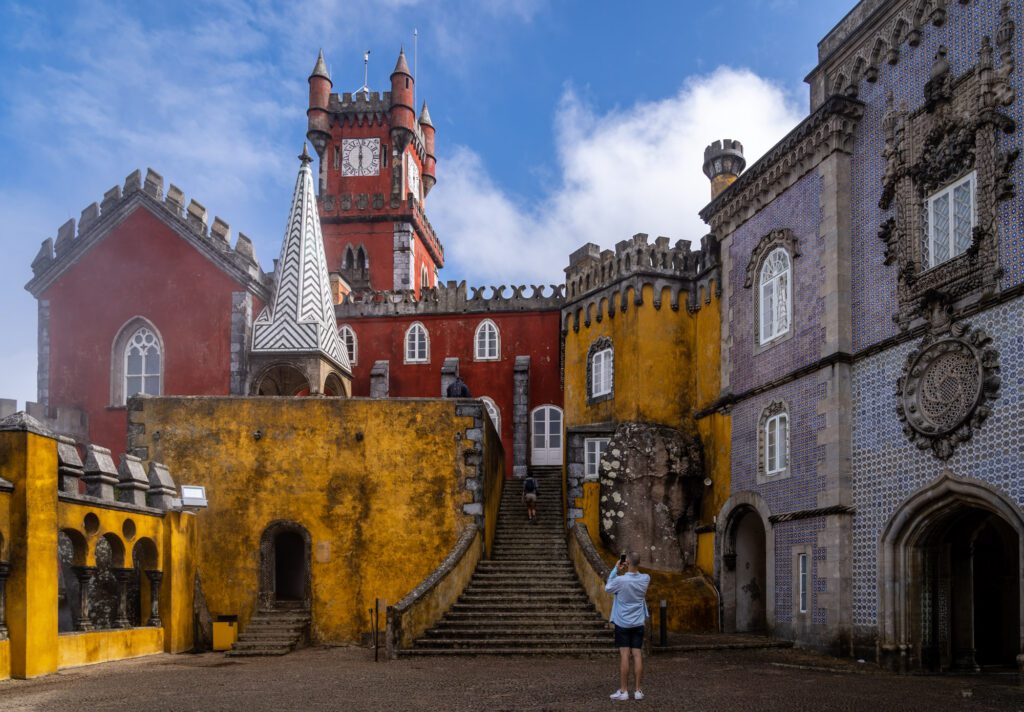
There are two parts of the Pena Palace complex, and they require different tickets.
There are the gardens, and then there’s the interior.
We decided to skip the interior – we’ve seen plenty of opulent palaces over the course of our travels, maybe the rich dudes should have spent the money that they spent on their summer home on something, I don’t know, more useful?
Seriously, Pena Palace is essentially a summer home, built in the Sintra Mountains by King Ferdinand II.
Originally, it was a monastery on the hill, but it was destroyed during the 1755 earthquake and sat there in disrepair for years.
Then, Ferdinand said “wouldn’t it be great to have a place to escape the oppressively hot Lisbon summers? Maybe a place on a hill, with nice views and a cool coastal breeze?”
12 years later et voilà! Pena Palace, built by German architect Wilhelm Ludwig von Eschwege.
Eventually, the state of Portugal bought the palace from the royal family (honestly, isn’t that insider trading or something?) and turned it into the museum it is today.
The colors and décor of the palace are pretty unusual. Just look at this odd guy sitting atop one of the arches on the exterior of the castle.
It’s an unusual mix of architectural styles, borrowing from multiple different eras and styles to create a multicolored mishmash.
We would recommend just getting a ticket for the grounds, and admiring the palace from the outside. Here’s how we’d spend your time:
- Start by exploring the gardens. When we arrived, the palace was fogged in and you could barely make out the bright yellow facade. If you find yourself in the same boat, fear not! It will likely burn off. Head out to the High Cross in the gardens, which is a nice view (if the fog happens to be gone – it wasn’t when we were there). In general, our favorite part of the gardens was the lakes area at the bottom of the hill.
- Then make the walk up to the palace. Admire the arches and tiles along the outside, and go up into the chapel, which is free.
- Walk the walls of the palace. There’s a short path around the palace walls, which you should save for last because it’s a great view out over Sintra and all the way to the coast, so you want it to be clear.
From there, head down through the gardens to the lower entrance, and walk up to the Moorish Castle.
Important Info: Reservations are not required for visits to Pena Palace, but you get 15% off if you book at least three days in advance. Tickets for the gardens cost €10, while combo tickets that include the interior cost €20.
As we said, we don’t actually recommend going into the palace. The castle is often shrouded in fog in the morning, which usually burns off by about 10:00 or 11:00 am.
For that reason, we recommend above that you spend your time admiring the gardens first before heading up to the palace itself. More info here.
Castelo dos Mouros
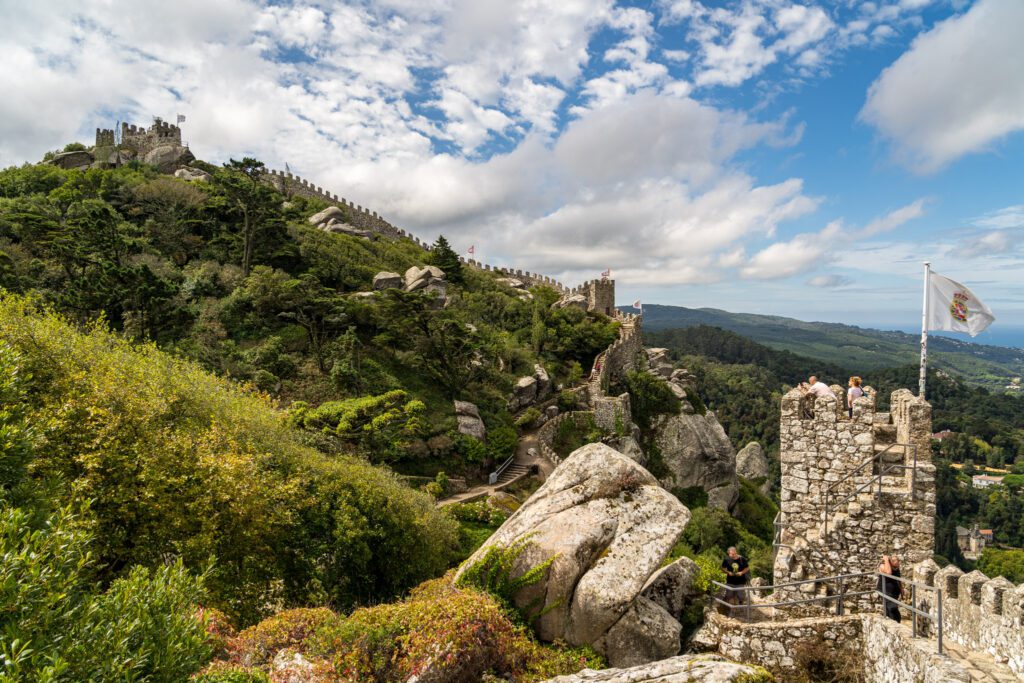
Honestly, we were SO close to skipping this. But we were so glad we didn’t!
Walking along the reconstructed walls of this Moorish Castle from the 8th or 9th Century was the highlight of our time in Sintra, and the views are nothing short of spectacular.
It was built when the Muslims from North Africa were in control of the Iberian Peninsula, and then it was taken by the Christians in the 12th Century, and basically left in various levels of desertion ever since as tensions calmed and people no longer felt the need to live within the castle walls and started making their way downhill towards Sintra and proverbial greener pastures.
At least until the 1800’s, when restoration efforts began under King Ferdinand in the same vein as the Pena Palace restoration.
There are some historical sights to see along the way, but we’d focus your time on walking the walls from one end to the other, which involves some steps (which are actually kind of hard), and is basically a nonstop spectacular view from start to finish. Go counter-clockwise.
Important Info: The cost to enter the castle perimeter is €12 (15% off if you book three days ahead). We originally balked at that cost, but afterwards decided it’s probably worth it for the great views alone. Plus, how often do you get to walk on former castle walls? More information here.
Getting to Sintra
Sintra is an easy 45 minute train ride from Lisbon’s Rossio Station in Baixa. Getting to Rossio is pretty easy from basically anywhere in Lisbon, including Baixa, Chiado, and Alfama.
The most important thing to know is that you will want to be on the first feasible train out to Sintra, which totally depends on how early you want to wake up.
The train we chose left at 8:11 am, which we think is the perfect time because you’ll arrive in Sintra around 9:00 am, and most of the attractions open at 9:30 am, giving you about 30 minutes to get up the hill to Pena Palace to start your day and beat the rest of the visitors.
Again, there is plenty more to know about planning a trip to Sintra. Rather than cover all of that information here in this already long guide, we’re going to direct you to our guide to planning a day trip to Sintra, which has everything you need to know – including logistics, what to see, and how to plan your itinerary.
What to Do with More Time in Lisbon
With more time in Lisbon, you have a couple of options for what direction you could go in terms of what you add.
Broadly speaking, those options boil down to spending more time in the city and taking things at a more leisurely pace (our choice) or adding another day trip to your agenda.
The thing to know here is that there aren’t necessarily a whole lot of attractions we’d add to your itinerary with an extra day or two. Lisbon is different from bigger European capitals like Paris and Rome in that regard.
By adding days in Rome or Paris, you’re allowing yourself more time to cover some of the lesser known museums and/or attractions, like the Rodin Museum in Paris (one of our favorites) or the Castel Sant’Angelo in Rome.
In Lisbon, you’ve already done a pretty good job at covering most of the “main” attractions, so there’s not a whole lot else to add here.
Our preference is to spend more time in Lisbon itself, and take things at a slower pace and/or tackle a few more experiences, like doing both a food tour and a cooking class, or taking the ferry across the bay to Cacilhas.
What to Do with Less Time in Lisbon
At a high level, if you have less than three days in Lisbon, we’d immediately cut Sintra. It’s great, don’t get us wrong, but we’d opt for spending your time in Lisbon itself rather than getting out of the city. Save it for next time.
With One Day in Lisbon
If you only have one day in Lisbon – and we mean one full day, morning, afternoon, evening, we’d spend it like this.
In the morning, head out to Belém and do the Torre de Belém, the Monument to the Discoveries, and the Jerónimos Monastery (though the cloister won’t be open when you’re there, which is fine) before going to Pastéis de Belém to try the alleged original pastel de nata.
Head back to Lisbon’s center and choose between the walking tour (if you’re more interested in history and culture) or the food tour (if you’re a foodie). Our preference is the walking tour, but you can’t really go wrong either way.
In the evening, follow the Alfama guide in the itinerary above and spend a few hours in the most romantic part of Lisbon, at least in our opinions.
PS: We have an entire guide dedicated to helping you make the most of one day in Lisbon.
With 2 Days in Lisbon
Follow days one and two of the itinerary above as written, which means skipping the day trip out to Sintra. Voila! 2 great days in Lisbon.
Planning a trip to Portugal?
Here are our other Portugal travel guides to help you plan an incredible trip (even if you have to eat gluten free!).
If there’s no link below, it means we’re still working on it – long, in-depth guides take time! We’re working on it, though, we promise.
Portugal:
- Exactly How to Spend One Week in Portugal (for First Timers)
- 10 Days in Portugal: Planning the Perfect Portugal Itinerary
Lisbon
- 25 Incredible Things to Do in Lisbon: A Complete Guide
- 3 Days in Lisbon: Planning the Perfect Lisbon Itinerary
- One Day in Lisbon: The Best of Lisbon in 24 Hours
- Where to Stay in Lisbon: Our Guide to 4 Amazing Places to Stay
- Gluten Free Lisbon: A Complete Guide to Lisbon’s Best Gluten Free Restaurants
- The Best Coffee in Lisbon: 9 Amazing Lisbon Coffee Shops to Add to Your List
Porto:
- 3 Days in Porto: Planning the Perfect Porto Itinerary
- One Day in Porto: How to See the Best of Porto in a Day
- Where to Stay in Porto, Portugal: The 3 Best Places to Stay
The Algarve:

I am so happy that I found your blog posts on Portugal. We had 3 days in Lisbon and 3 days in Lagos. Your recommendation of the Be Poet Baixa Hotel made for easy walking to many of your suggestions. They also offered lots of information about sites and restaurants in the area. We enjoyed our time in Portugal and will be back again.
Hey Wendy! Glad you found it helpful and enjoyed your trip. Baixa is great in terms of location – you’re within a short walk or bus ride of just about everything! We like Chiado a tiny bit better in terms of vibe, but both are excellent choices. Noted on Be Poet Baixa – thanks for the info.